How do the French celebrate Christmas? I’m glad you asked it… for there is much to say about one of my favourite topics! Did you know that the French traditions of Christmas play an integral part in celebrating the birth of Jesus in France?
Well, the festive season consists of many favourite customs such as the Christmas tree, the chocolate bûche, the Père Noël and the great Christmas Eve dinner. Follow me on this cultural journey and learn more about France’s Holiday season!
In this post, we’ll be covering 15 top French traditions of Christmas.
What are the French Traditions of Christmas?
Many European countries, including France, consider Christmas the most important time of the year. Over the centuries, the celebration of Christmas has evolved according to the traditions inherited from Christianity and paganism.
Thus, some of the French traditions of Christmas have emerged while others have been forgotten.
The various traditions of Christmas in France
France, being a country of passage between Northern Europe and the Mediterranean, has adopted various Christmas traditions. The traditional Christmas in Provence is inherently different from that in Alsace. This is also reflected in Christmas gastronomy.
The globalisation of Christmas
However, with the development of globalisation since the end of the Second World War, there has been a standardisation of Christmas traditions in France. The most striking example is the appearance of Santa Claus, the American Père Noël, in French society. The big fat man dressed in red has dethroned the traditional gift distributors. Who remembers Père Chalande or Bonhomme Hiver?
The great influence of Germany
Another country that has had an important influence on the French Traditions of Christmas is Germany. Alsace, a Germanic province by history, was the springboard for developing Germanic Christmas traditions in France. This is the case for the traditions of the Christmas tree and Christmas markets.
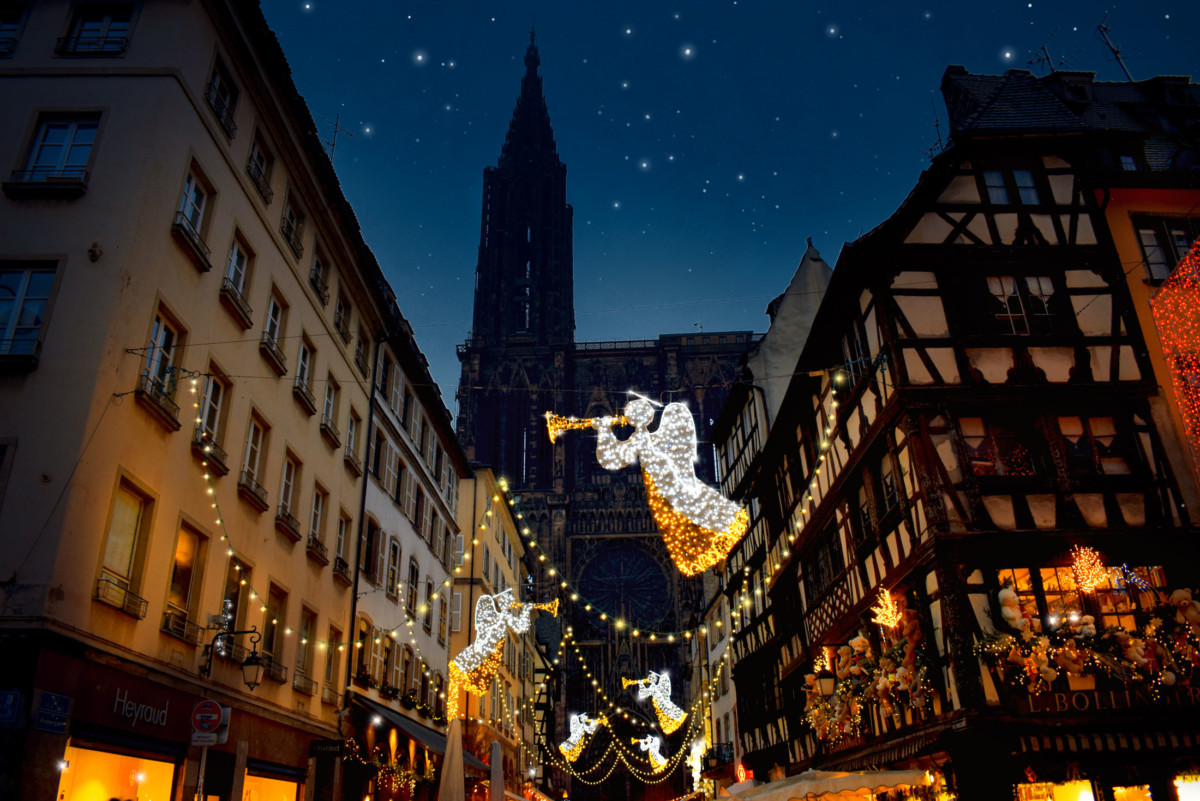
The French Traditions of Christmas start with Advent
Advent calendars
Advent Calendars (calendriers de l’Avent) are, of course, a treat to eager French children in anticipation of Christmas. However, the original versions contained pious images, toys and chocolates filled with modern-day ones. At Christmas, the local postman or firefighter would knock on every door, selling calendars for the coming New Year. The French people call these post office calendars “Almanach du facteur”.
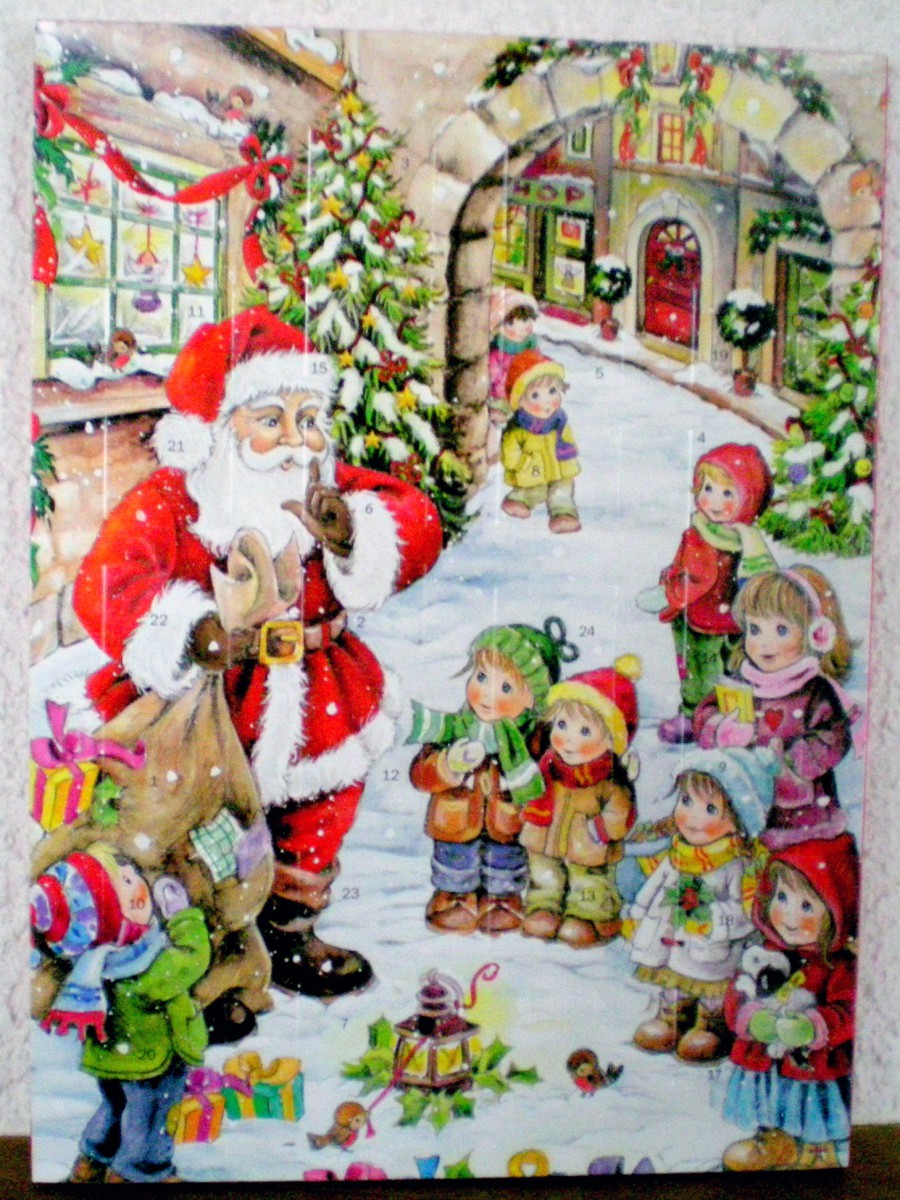
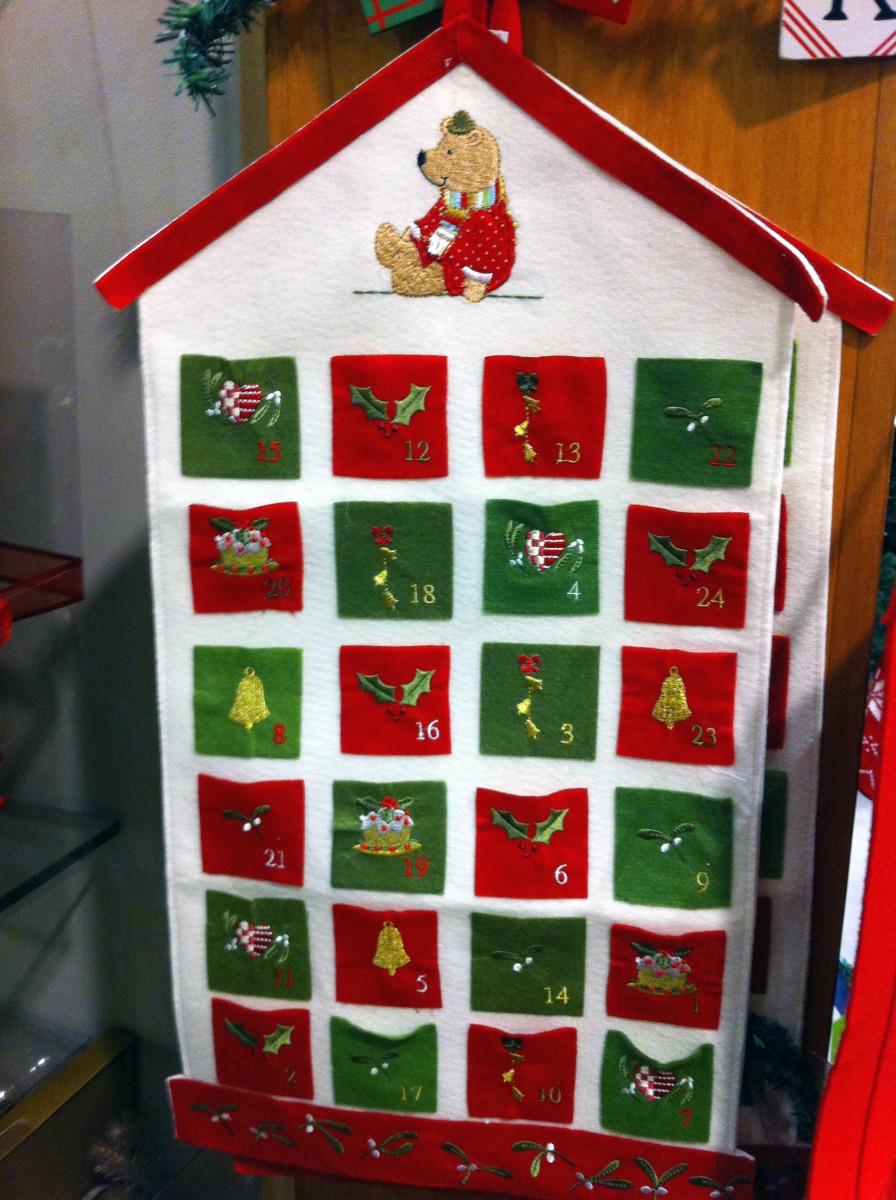
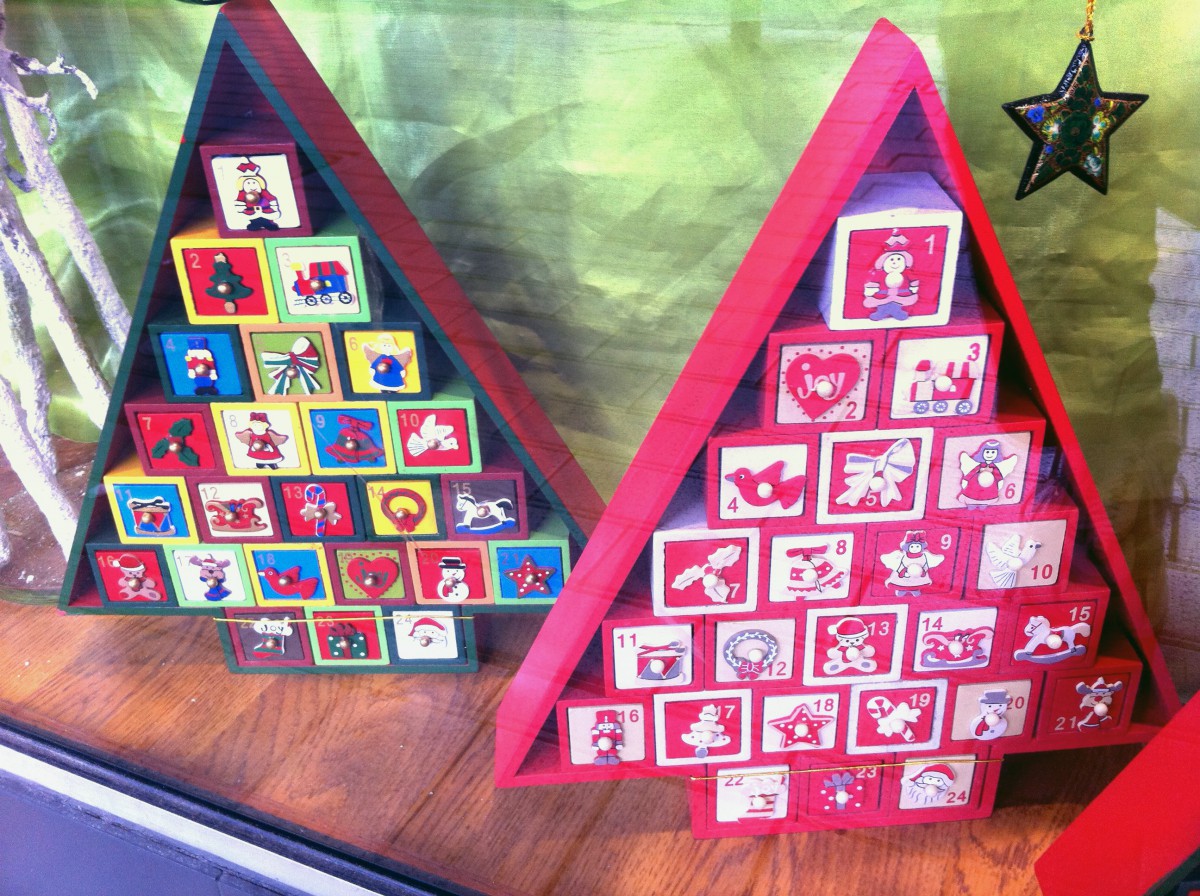
Alongside the calendar is the decorated wreath. With its four candles, this is another French tradition of Christmas.
Advent wreaths
The Advent wreath (couronne de l’Avent) consists of fir and pine tree branches. It is traditionally knotted with beautiful red bows and decorated with pine or fir cones. Four candles top the Advent wreath. They symbolise the four Sundays leading up to Christmas. People then lit a candle on each Sunday preceding Christmas.
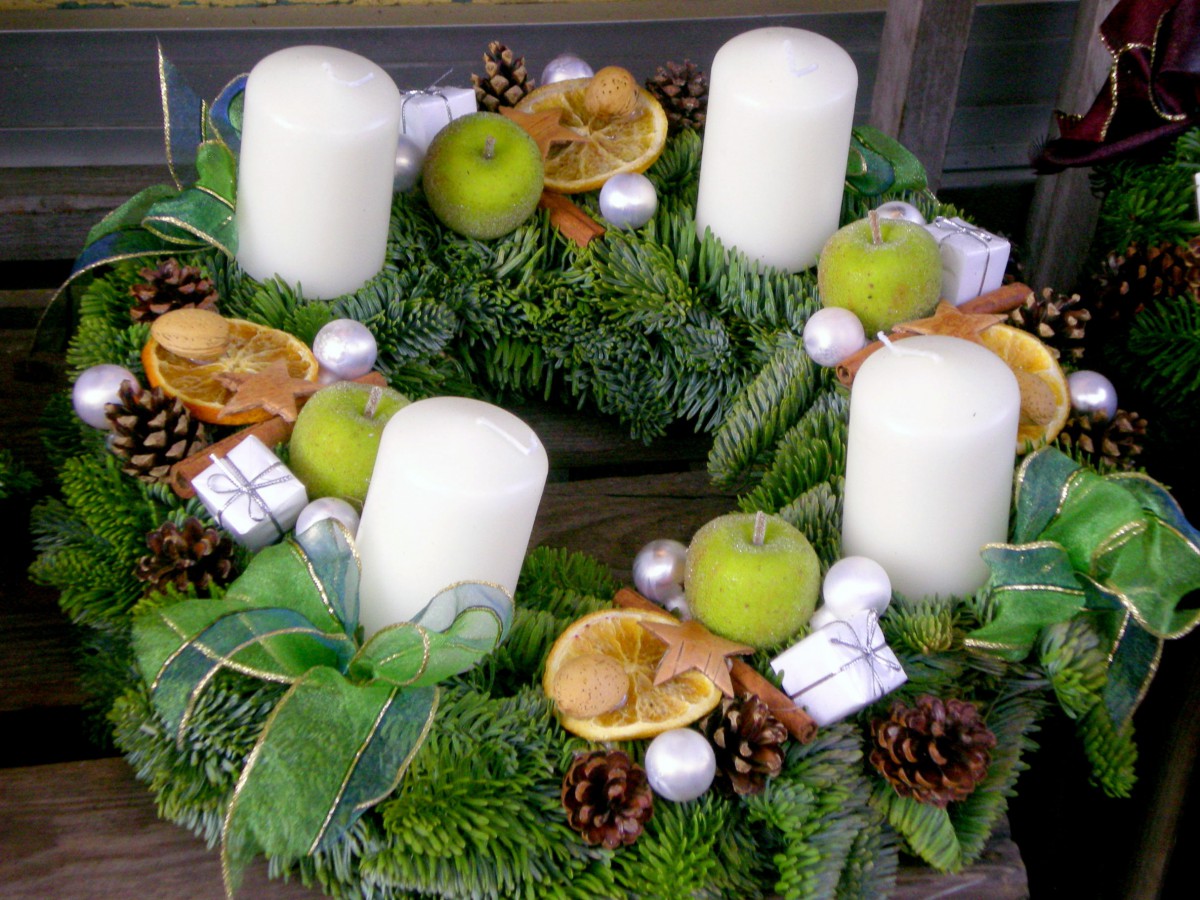


Did you know? The cathedral of Strasbourg displays one of France’s largest Advent wreaths in the nave.
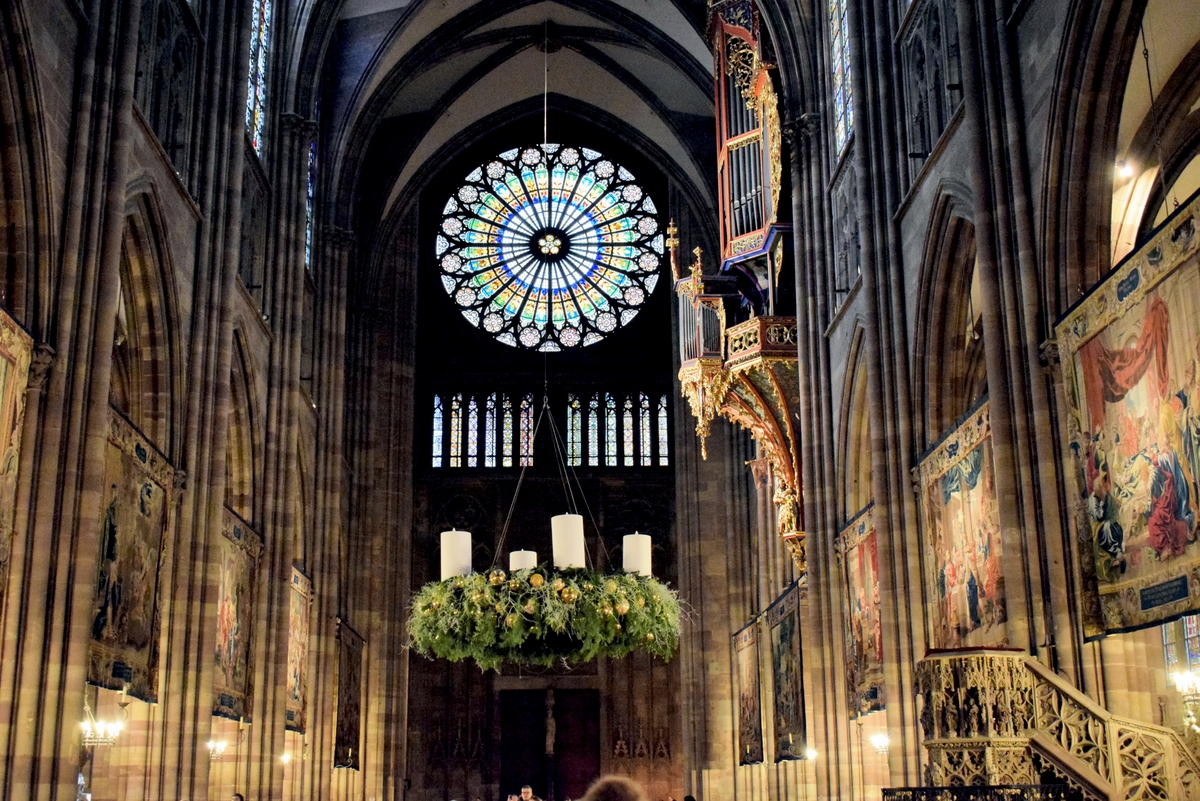
Read more about these French traditions of Christmas: Advent in France.
The Christmas Tree in France
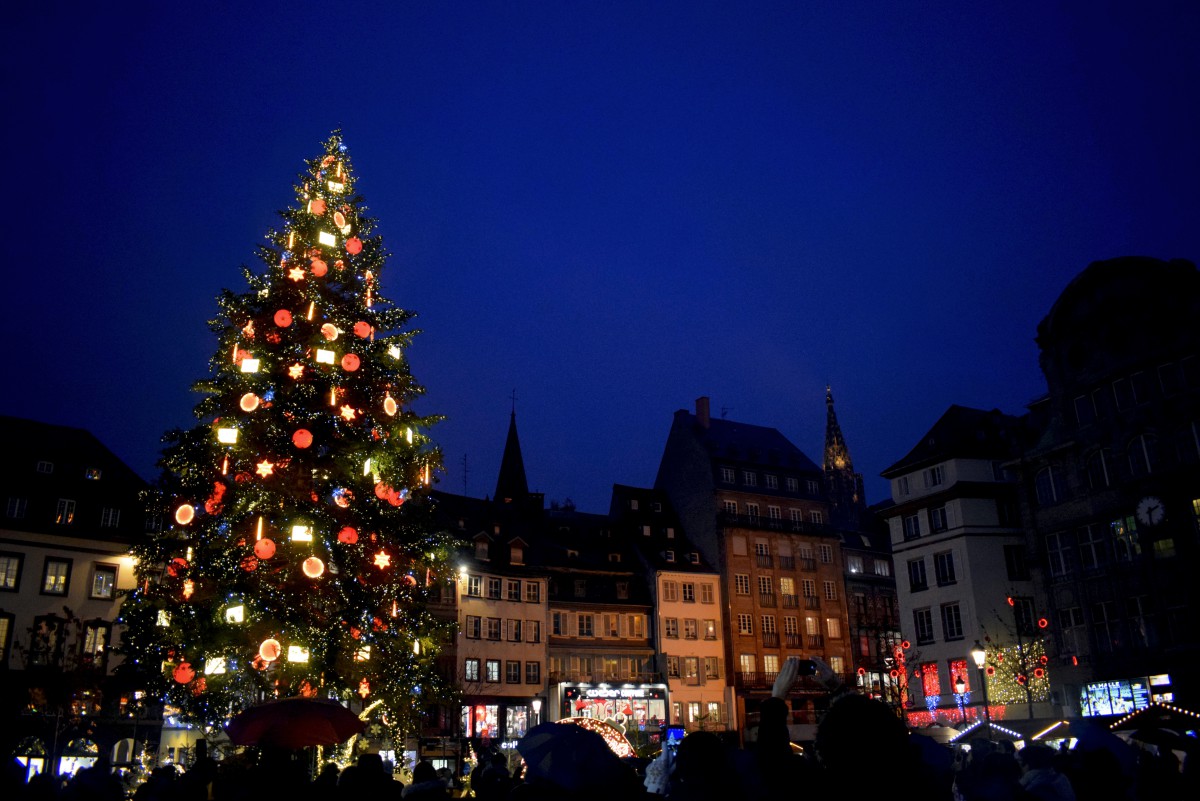
The Christmas tree is one of the most famous French traditions of Christmas. It has become an iconic figure of Christmas since its origins in the 16th century.
For decorating the Christmas tree (sapin de Noël), French people have a wide choice of:
- ornaments,
- glistening tinsel,
- blinking fairy light,
- without forgetting a star at the top.
This article on the French Christmas Tree will tell you when and where the tradition started and how it became a significant part of the holiday festivities.
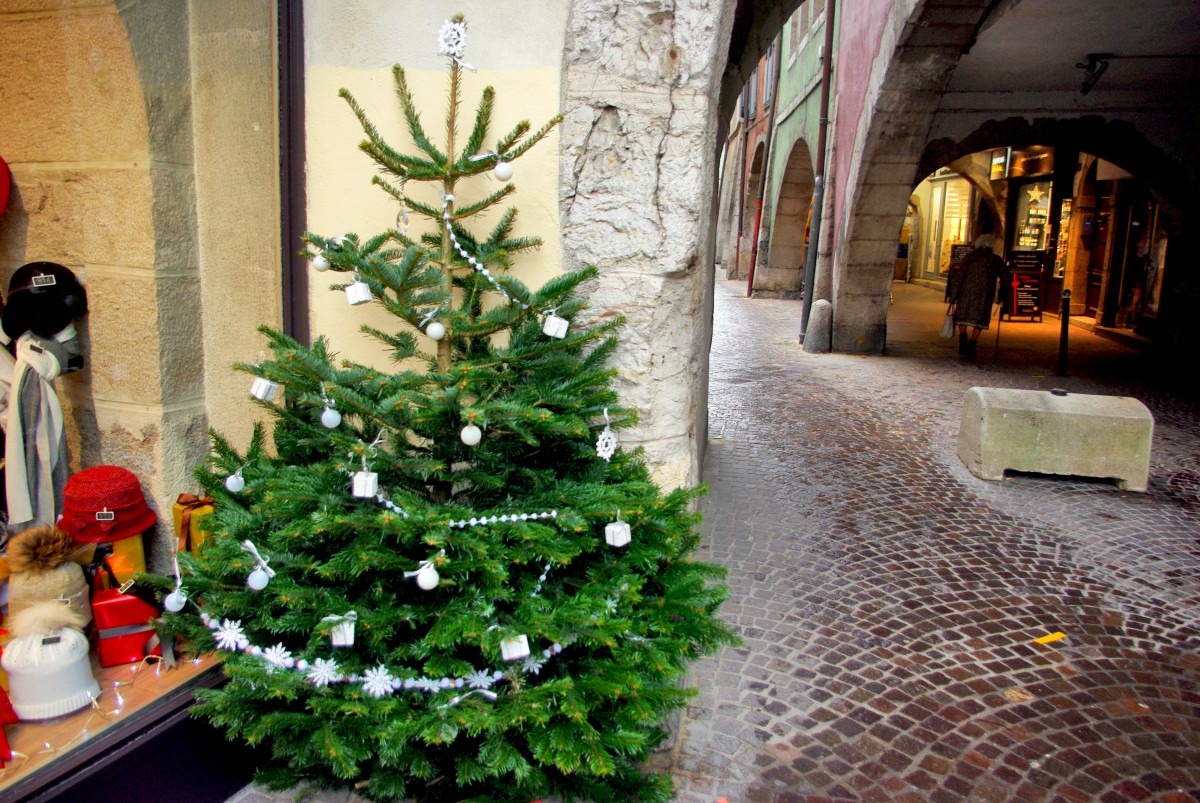
In France, the Christmas tree first appeared in Alsace in 1521. The French called it “sapin de noël” or “arbre de noël”. The tree, covered in red apples and lights, symbolised the venue of Christ, ‘the light that illuminates the world’.
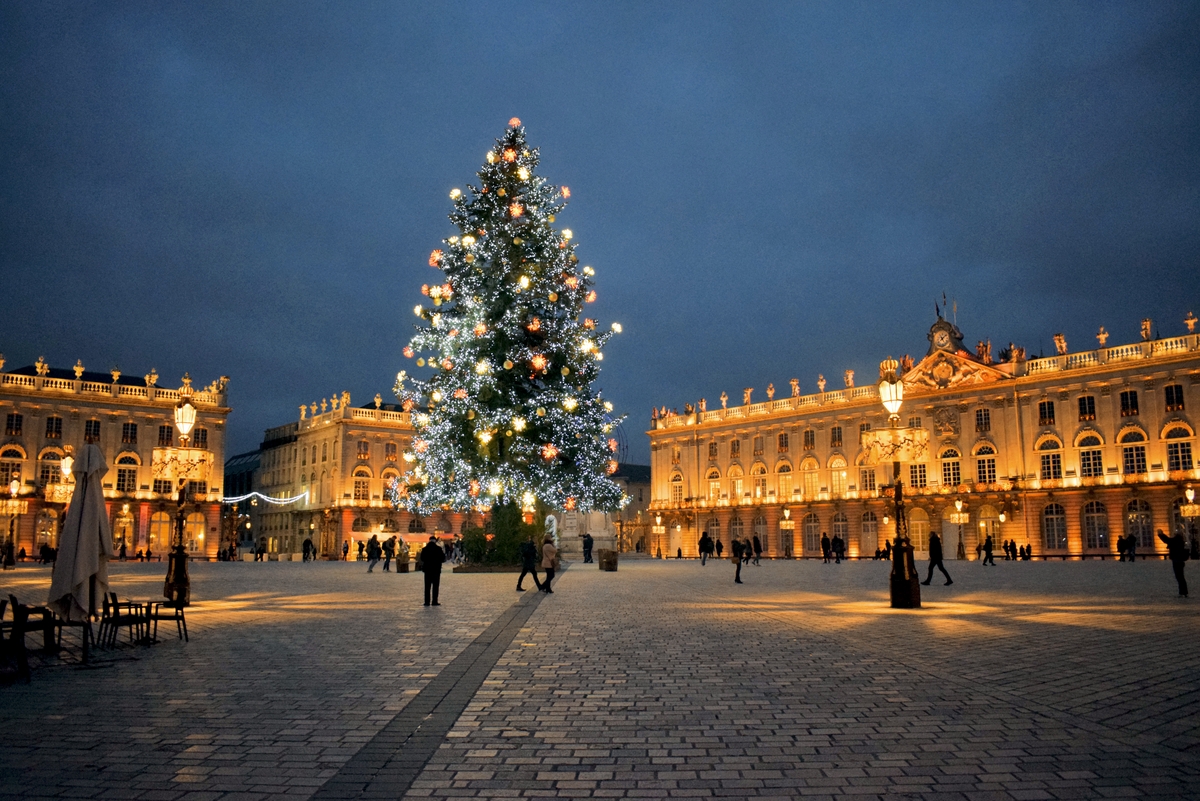
A fir tree is the best choice because they do not lose their leaves during winter, which doubles as a symbol of hope and eternal life. It is a more secular tradition than that of the Nativity. And thus more appreciated by protestant countries such as northern Germany and Scandinavia.
Read more about the French traditions of the Christmas tree and Christmas decorations.
From Saint Nicolas to Père Noël
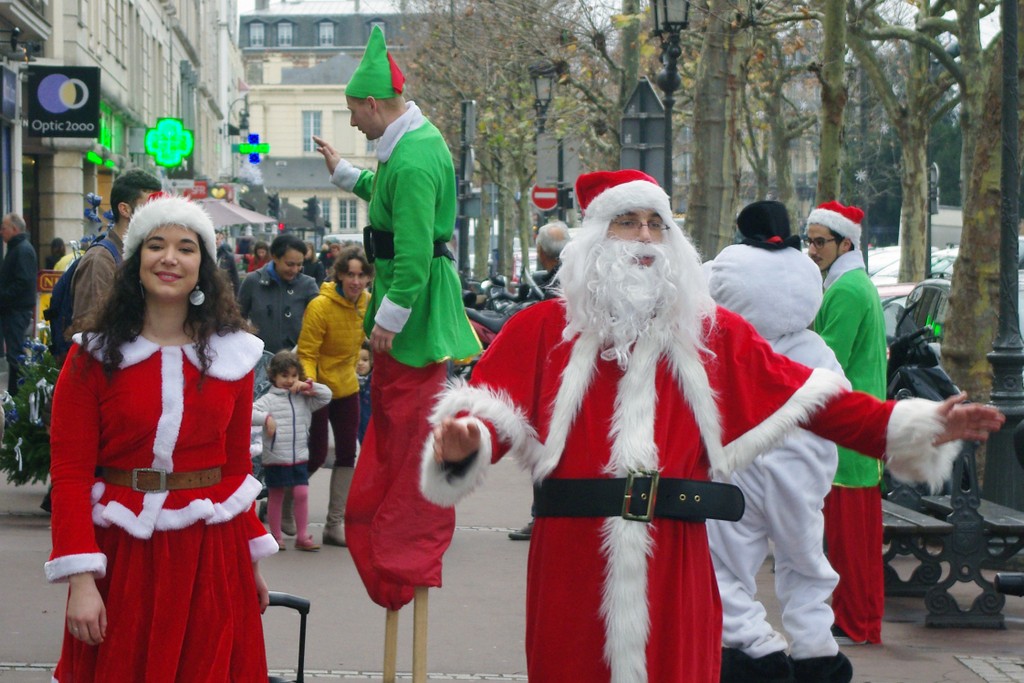
“Père Noël” (Father Christmas) is Santa Claus in France. Like in any place celebrating Christmas, the French Père Noël wears:
- a red suit and hat
- with white fur trimming
- with a broad black belt around his waist.
He is:
- tall and large,
- with rosy cheeks and nose,
- bushy eyebrows,
- a white beard and moustache.
His big brown sack carries lots of toys. Santa will deliver them in every household at midnight, using his sleigh pulled by reindeer.
Saint Nicolas and Père Fouettard
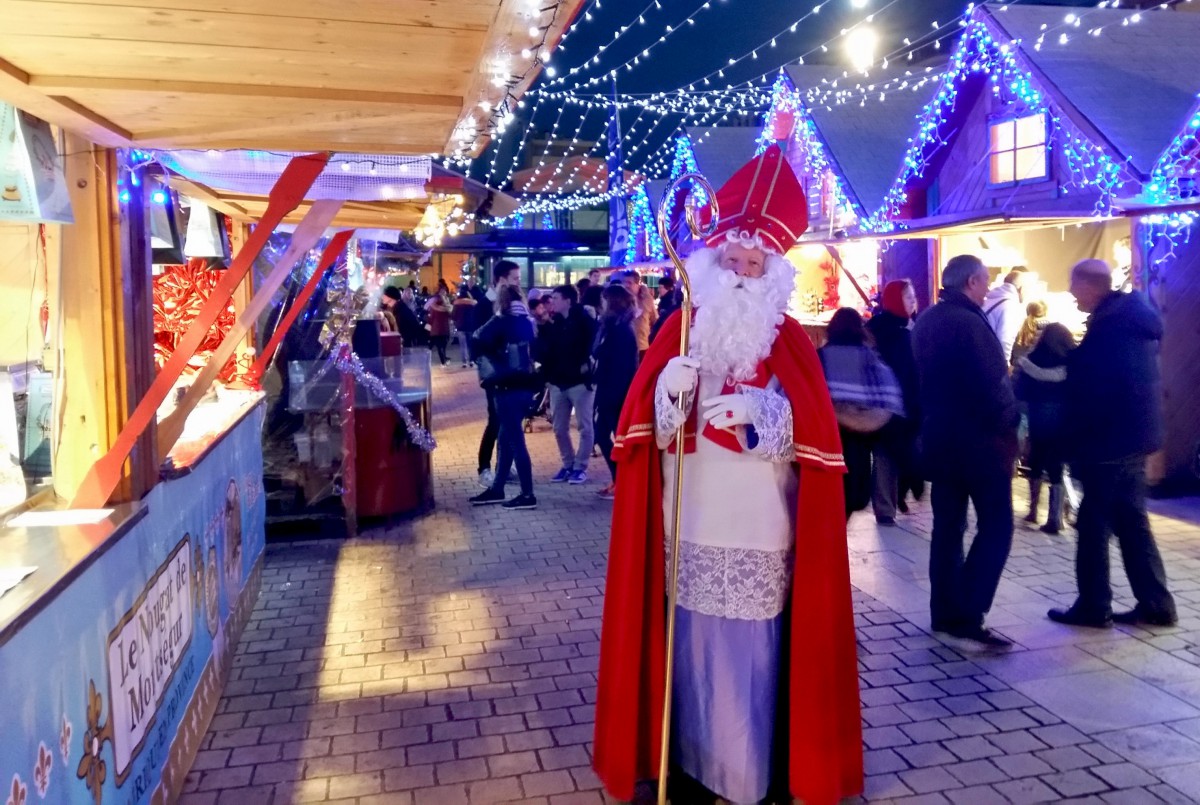
Saint Nicolas (Sinterklaas) inspired the character of Santa. The Patron Saint originally distributed presents to German and French children on 6 December. Père Fouettard (the Bogeyman) is Saint Nicolas’ counterpart. The French represent him covered in coal marks and dressed all in black.
He whips/spanks misbehaved children, just as Saint Nicolas rewards the good ones. With the transformation of Saint Nicolas into our modern-day Santa, Père Fouettard has somewhat disappeared altogether. In fact, he has given way to other characters, such as elves and reindeer.
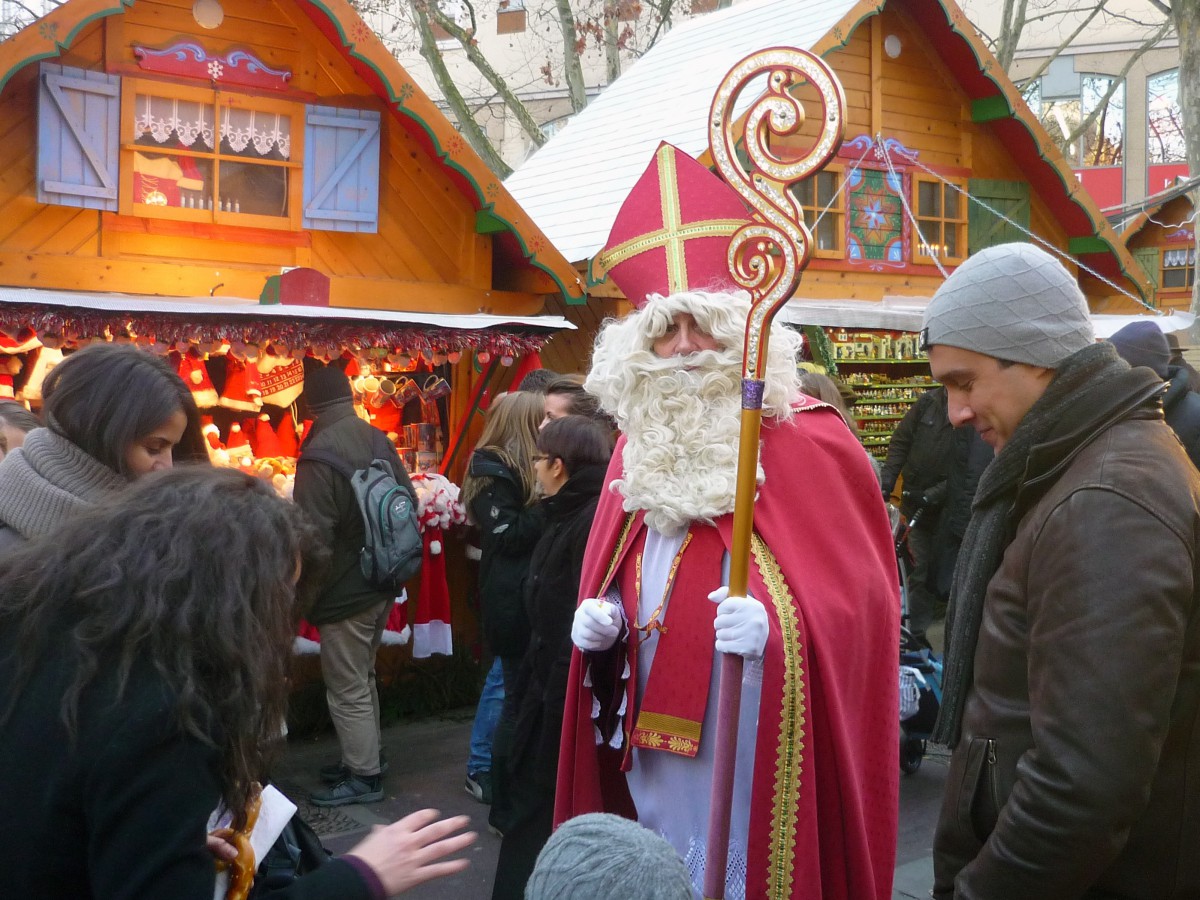
Saint Nicolas is the central character of celebrations in Flanders, Lorraine and Alsace, as well as in Austria, Germany, Belgium and the Netherlands. When the Dutch migrated to the United States in the 19th century, they took the traditions of Saint Nicolas (Sinterklaas). The character gradually evolved into Santa Claus.
The fireplace of Père Noël
On Christmas Eve, French children used to fill their shoes with carrots and treats for Père Noël’s donkey and leave them by the fireplace.
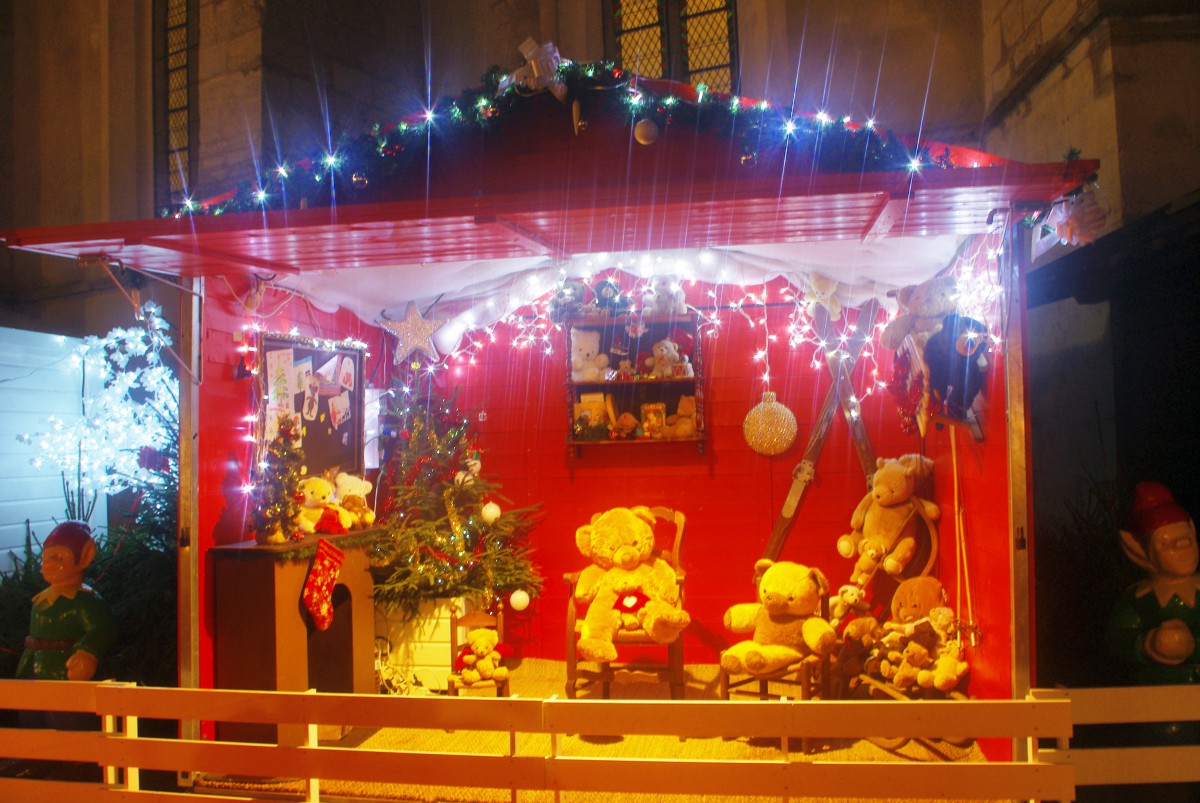
More recently, the fireplace has been replaced by the Christmas tree. On Christmas night, Père Noël is said to travel the world. He would stop at every house. And climb down through the chimney to leave presents for every child who has behaved themselves through the past year. Sometimes, Père Noël’s donkey is substituted by seven magical reindeer who pull his sleigh, which is, in fact, an American tradition.
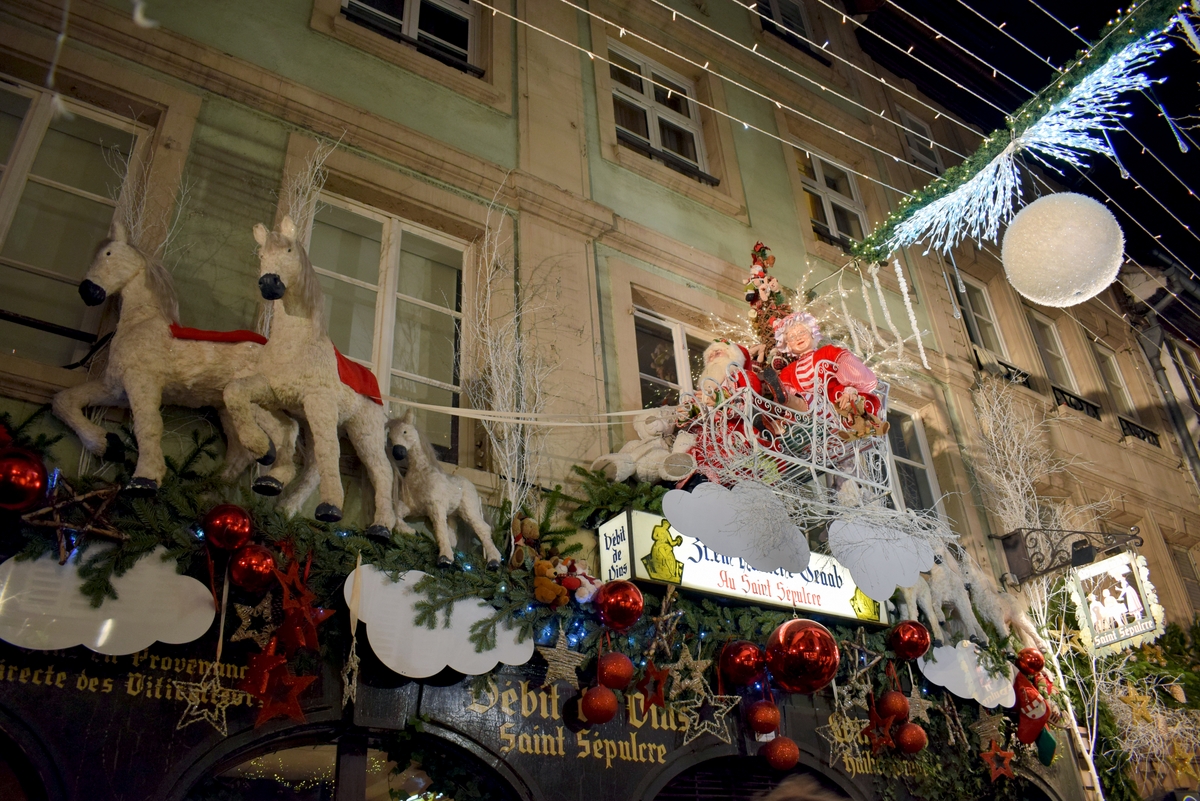
On Christmas morning, children run to the Christmas tree to see what Santa has left under it for them. Often, presents are opened on the evening of 24 December, after the Christmas Réveillon dinner or after the midnight mass.
Read more about Santa Claus.
The Christmas Presents
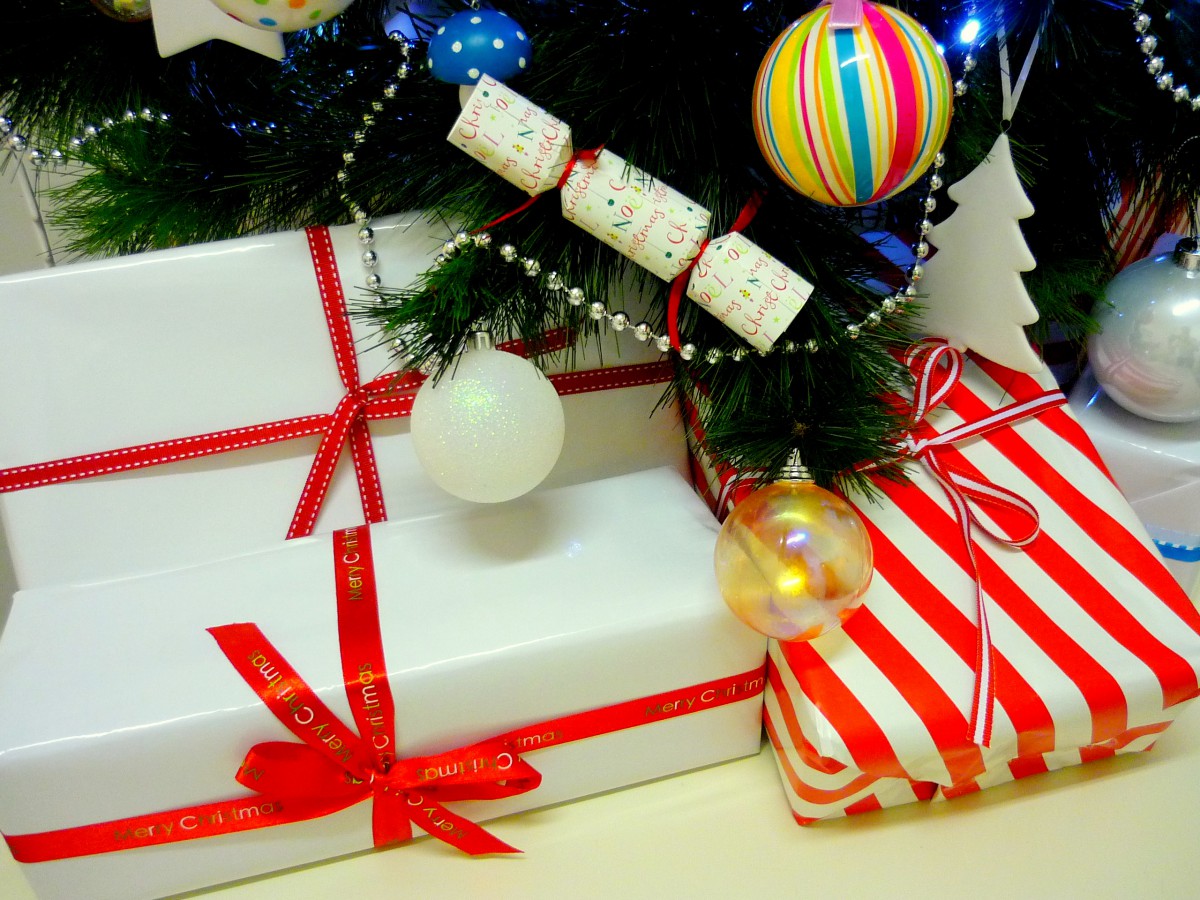
The presents offered to each other at Christmastime represent Saint Nicolas’s caring attitude toward children. They are also symbolic of the gifts the three wise men offered Jesus on 6 January (at Epiphany) when they arrived at the stable.
Until the 1960s, children in France received an orange and a small gift for Christmas. They were placed in a stocking. Colourful wrapping paper and the tradition of buying more expensive gifts developed in line with increased American influence after the Second World War.
The Nativity scene
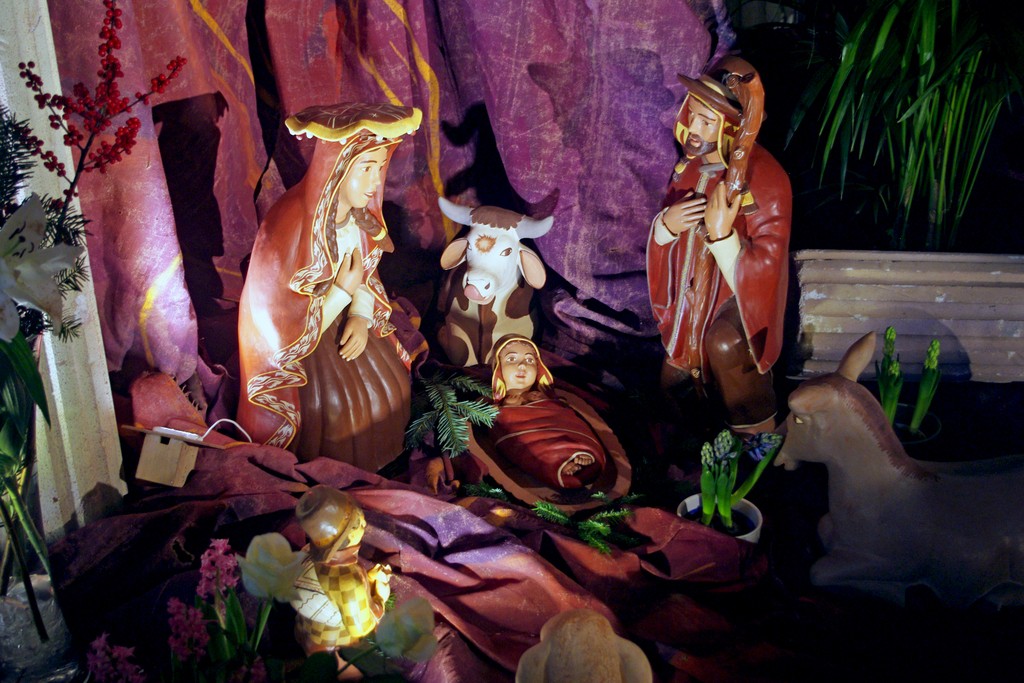
The Gospel of Luke recounts the story of Christ’s birth in a stable. His mother, Mary, wrapped him in cloths and laid him to sleep in the stable’s manger. Created around the 13th century, this tradition started spreading among Christians. Nativities (with life-size statues of the characters) and plays have been displayed in public places for centuries.
The Birth of Jesus
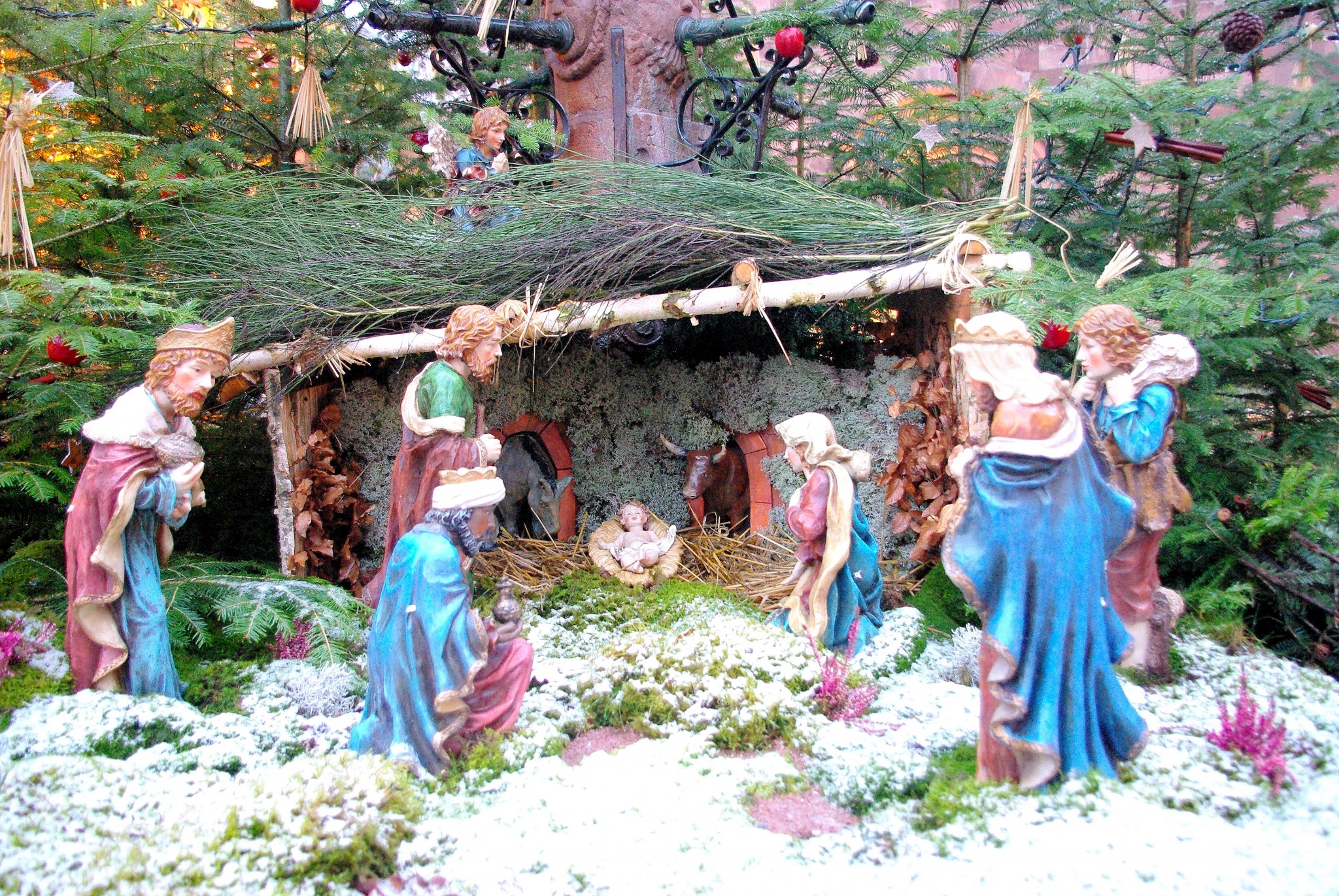
In the 4th century, the date of 25 December was decided upon as the birth date of Jesus. Since then, every year on 25 December, a figurine representing Jesus has been placed in the nativity. (some nativities have it already present, though it is positioned upside down until Christmas Day). The first nativity known to man dates back to the 6th century. Writings of that period describe the Christmas celebrations as centring around the nativity: “ad praesepe”, in the church of St. Mary in Rome.
The first Nativity scenes
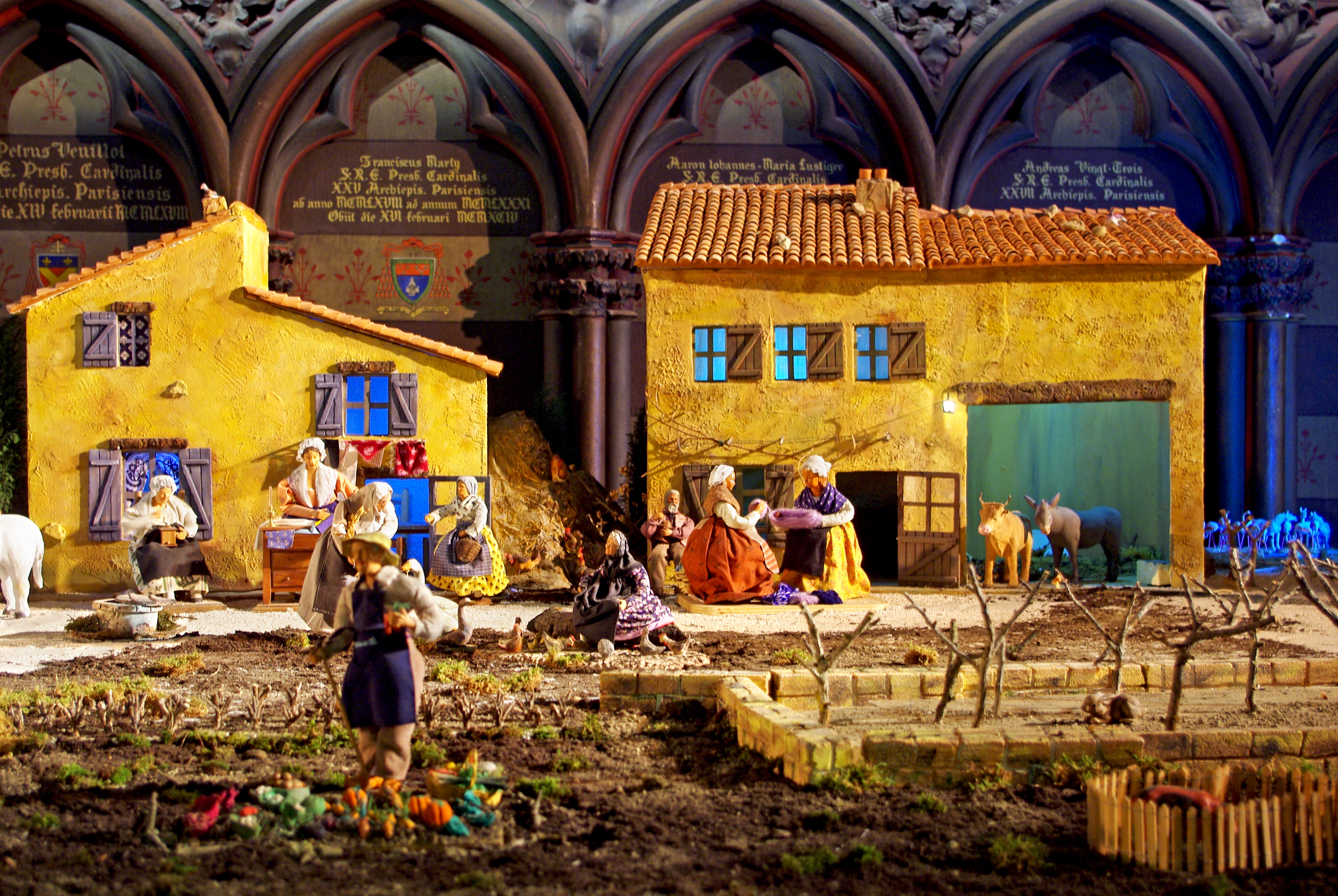
In 1223, St. Francis of Assisi created the first living nativity with people from his church in Greccio. Villagers played the characters. The role play even included live animals!
St. Francis put a consecrated host in the nativity to represent the baby Christ, although a live infant later replaced it. Little by little, the custom spread. Apart from Provençal nativities and live ones, there are also Baroque, Neapolitan, and Comtoise nativities (from Franche-Comté) as well as theatre nativity scenes (which were presented in the town hall square of Paris for 17 years).
A variety of Nativity scenes in France
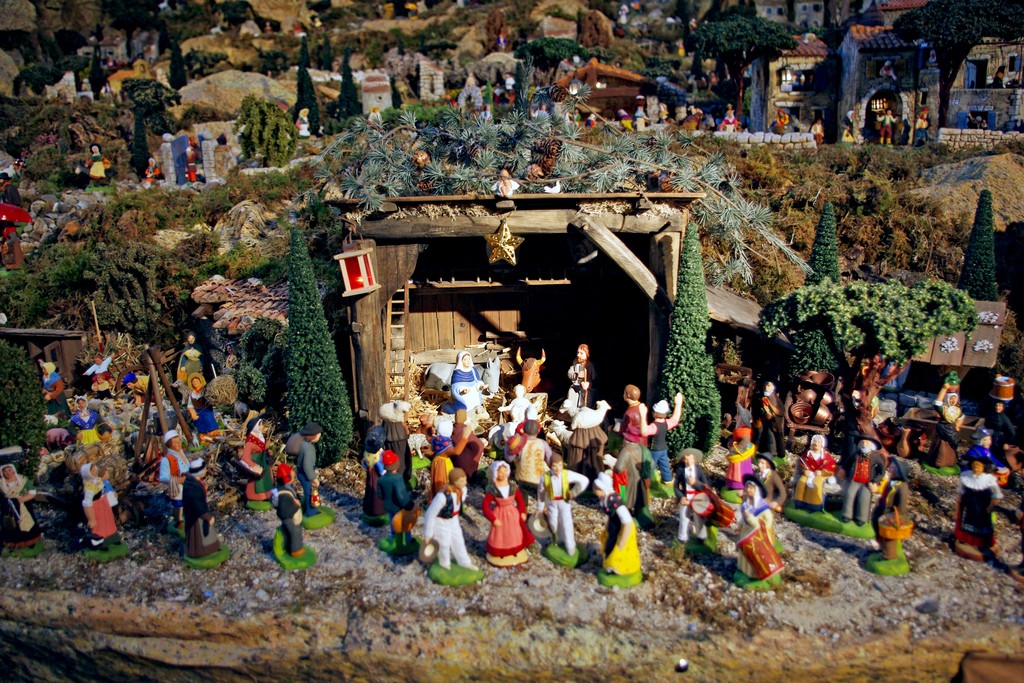
During the banning of street nativities throughout the French revolutions (closing of churches and suppression of the midnight mass), French households started reproducing the scene in their own house in miniature versions with clay figurines. This was when the Provençal Nativity began to develop. It has now become an essential tradition in the region. Contrary to the traditional nativity, the Provençal nativity mingles biblical characters (Mary, Joseph, the donkey and the ox, the three wise men) with typical Provençal villagers (the town crier, the poacher, the old man and woman: Grasset and Grasseto, the washerwoman, etc…).
Read more about the Nativity Scenes in France and Nativity scenes in Provence.
Christmas Eve in France
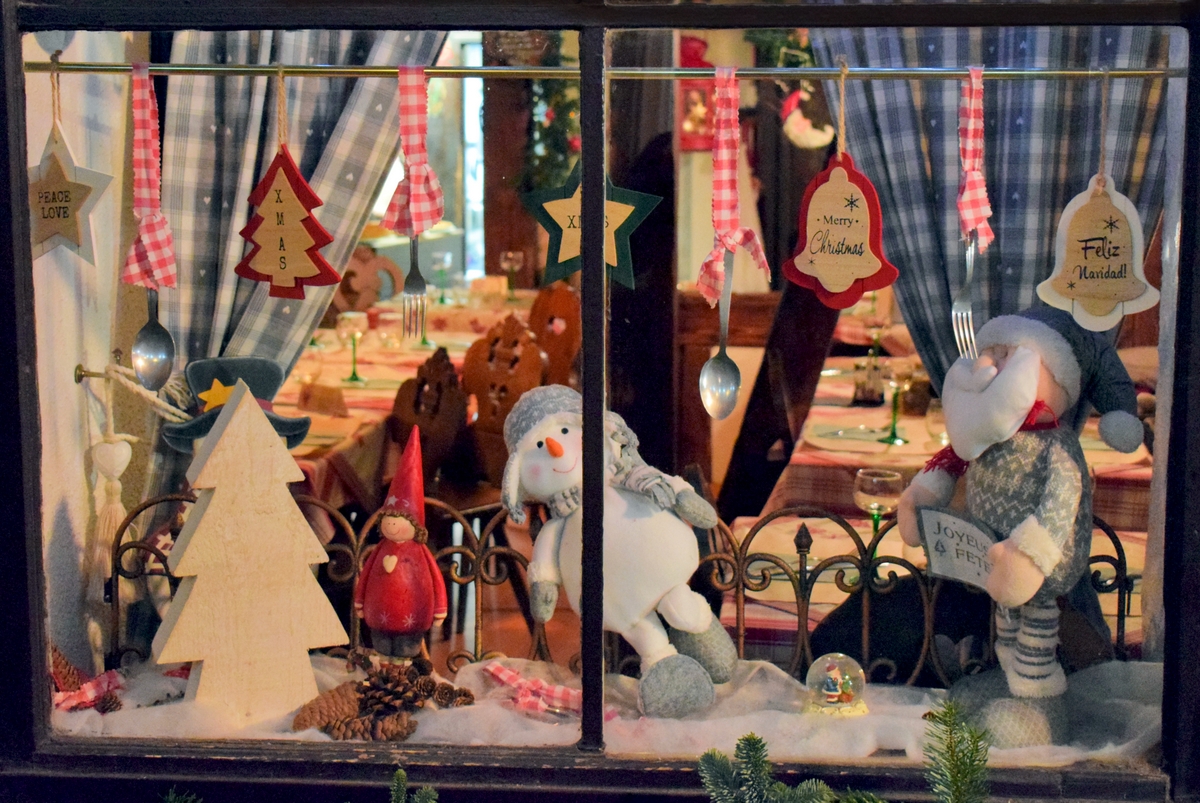
The Réveillon is the big dinner French people share with their family on 24 December.
The menu varies according to the region. But the family always has to sit down together and enjoy a variety of the most delicious dishes.
Christmas is a time for celebration; thus, the French indulge in luxury food and delicatessen.
The Réveillon dinner can continue for up to six hours in some families, and it is a very sacred tradition to the French. Eating at the table for a long time is also a social custom in France. It is also intended to be a magical and unforgettable moment for children.
This is the perfect occasion for everyone to “blow out” their food budget and savour snails, frog legs, scallops (Coquilles Saint Jacques), and truffles.
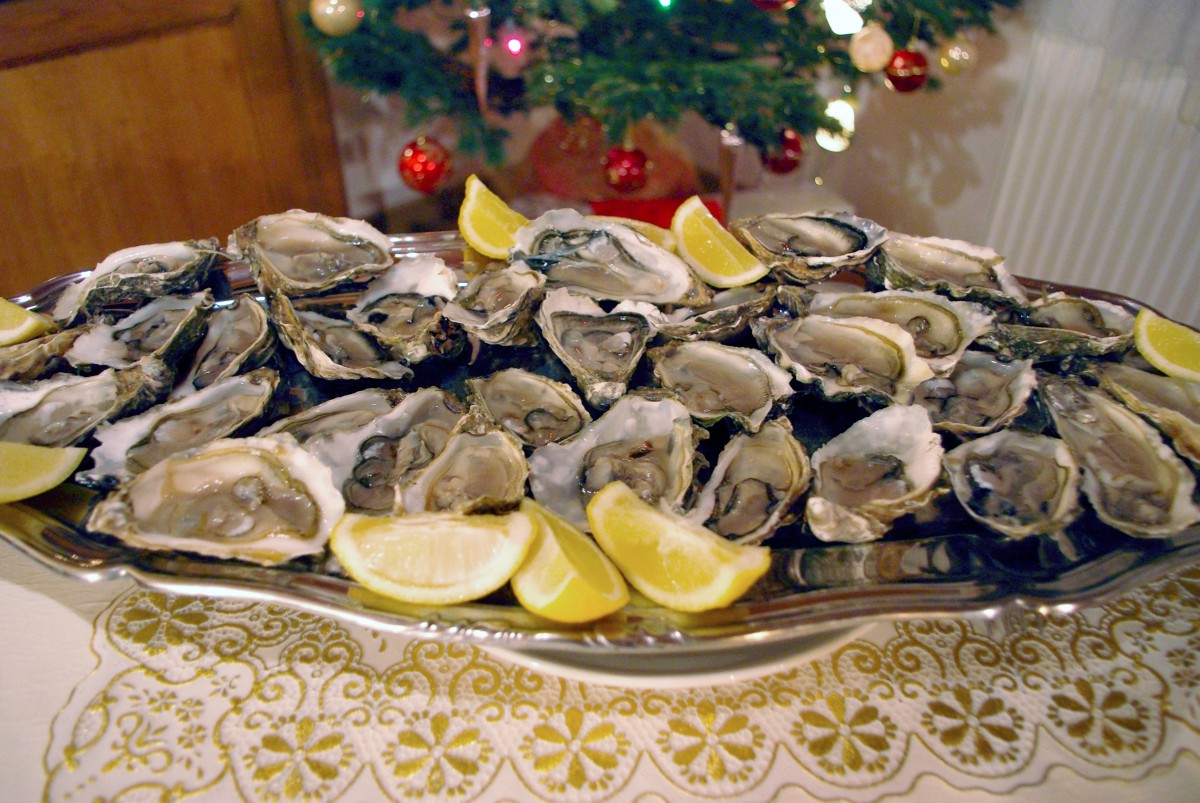
Parisians usually have seafood and oysters with bran bread and butter, caviar, foie gras (goose liver pate) with currant jam and the famous Christmas Yule log (a chocolate cake in the shape of a log decorated with plastic or sugared Christmas objects).
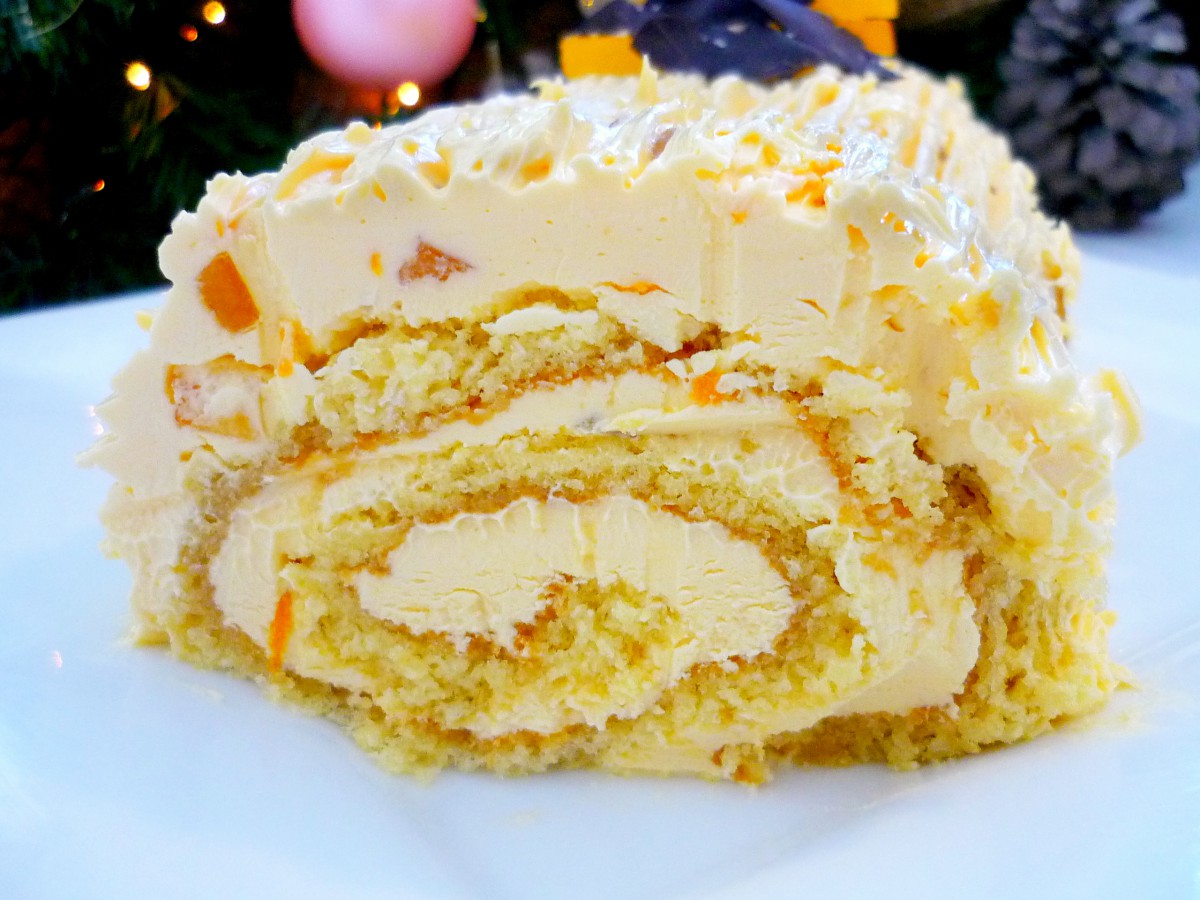
Christmas Eve in Provincial France
A roasted stuffed turkey/capon with potatoes is more common in Alsace and Burgundy.
In Provence, turkey is also found on the table during the Réveillon. However, some more religious families would argue that meagre meats, such as fish, should be eaten instead. Foie gras is also consumed in Provence, as is the dessert Yule log. However, it is a tradition to eat 13 desserts in Provence. They are used to symbolise Jesus and his 12 apostles (orange, pear, apples, prunes, melon, white nougat, black nougat, pompe à l’huile [a flat cake filled with olive oil], sorb, dates, dry figs, almonds, nuts or hazelnuts, black raisins).
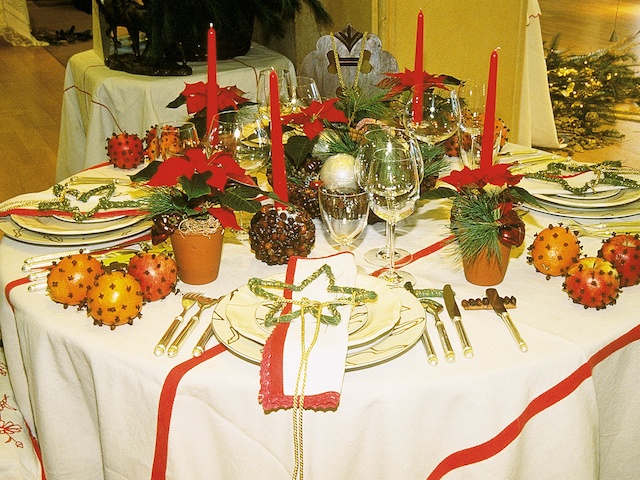
French people take a great deal of care when creating decorations for the Christmas Eve dinner. This is particularly true for placing ornaments for the dining table, which must look elegant and inviting.
On Christmas Day, food is still an essential part of the day, particularly at lunchtime when it is expected to eat an exceptional dish, such as rabbit, coq au vin, vol-au-vent (bouchées à la reine), etc.
The Midnight Mass
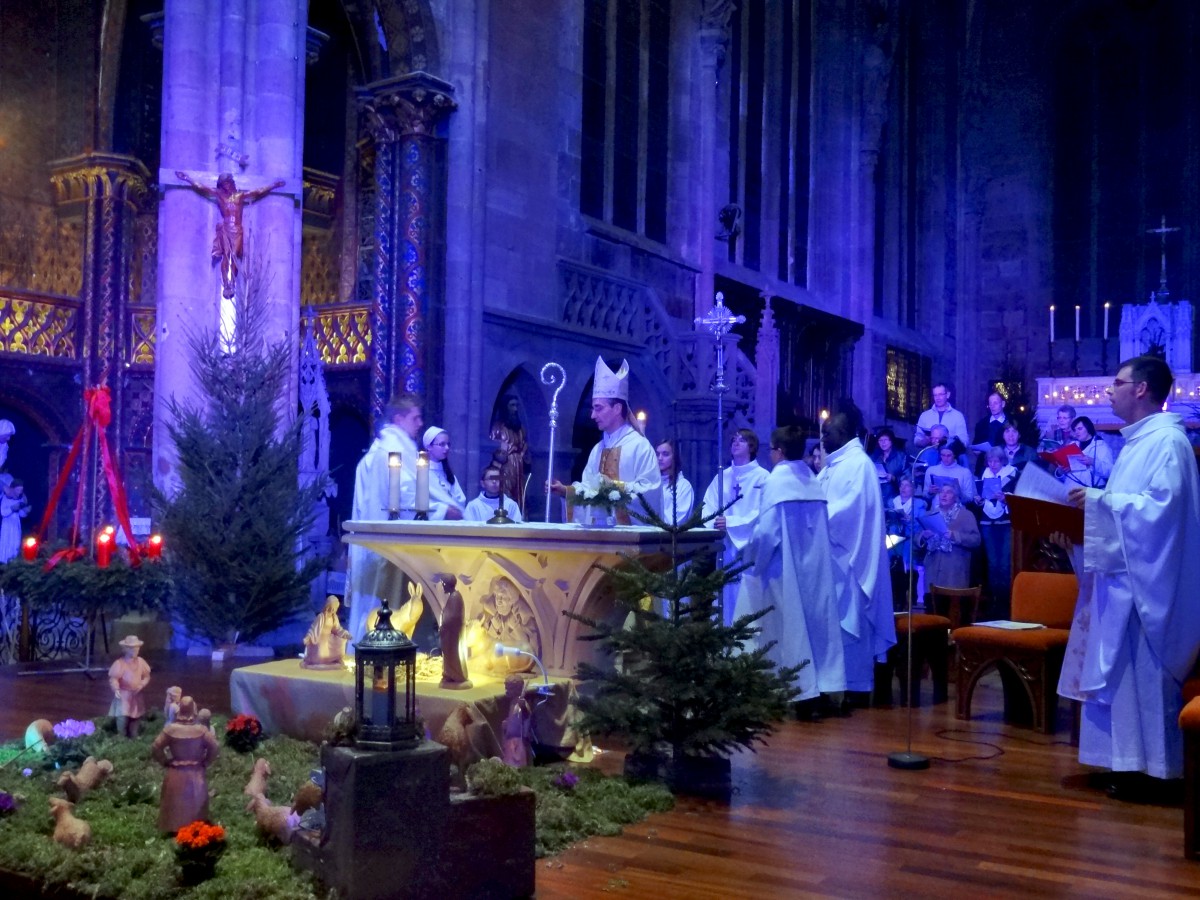
On Christmas Eve, the midnight mass is part of the French traditions of Christmas. However, not everyone will be joining the church on that night. The religious service usually starts at midnight or a few hours before in all the cathedrals and parish churches all over France. Families get together in prayer and carol singing to celebrate the birth of Jesus Christ, a tradition believed to have occurred at night.
For the occasion, people decorate their churches with Christmas candles, Christmas trees and a Nativity scene.
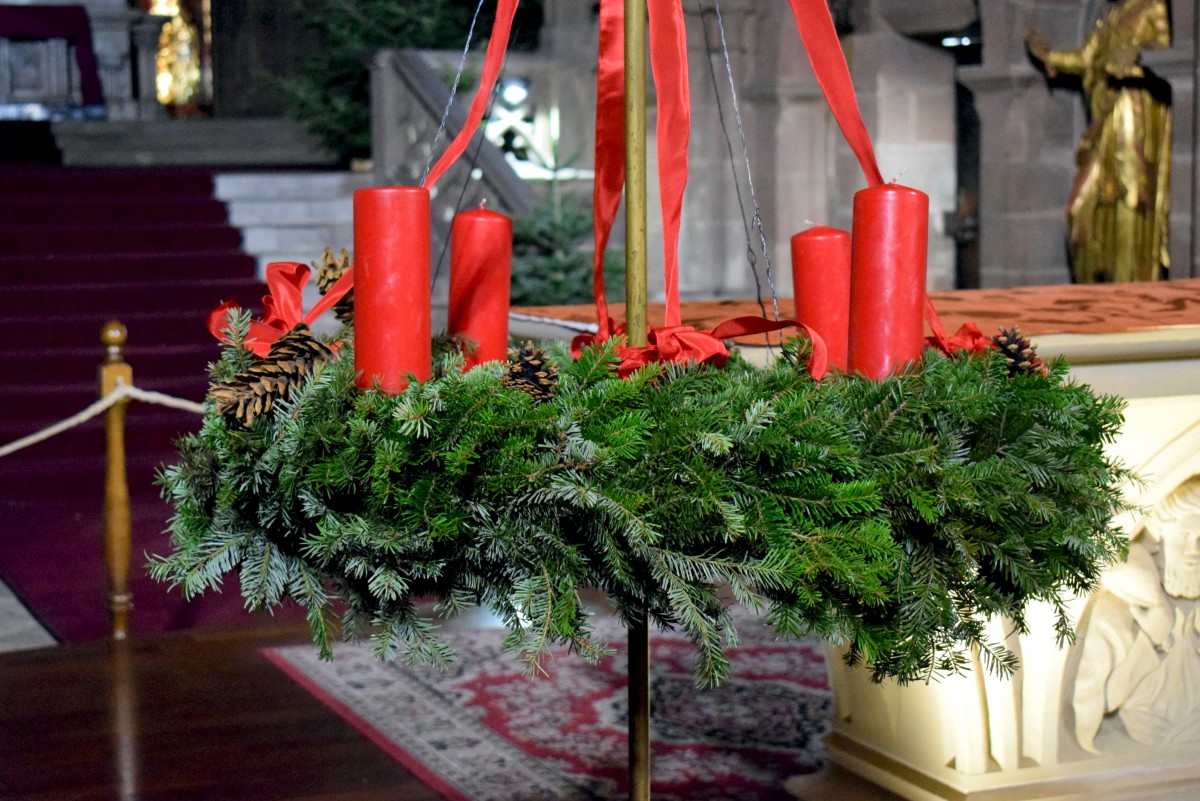
Some families return home after the Mass to savour the French Christmas log and occasionally to open their Christmas presents.
French Carols
Each region of France has its own Christmas songs. This is particularly true in Provence. The oldest of French carols still sung today is “Entre le bœuf et l’âne gris”. It was written in the early 16th century.

The French call Carols either “des chants de Noël” or simply “des noëls” (masculine, without the capital N).
Christmas carols in France:
- the “cantiques” (sung in churches) and
- the “chants profanes” (with a distant or no reference to the Nativity).
Some of the most famous French carols heard in English-speaking countries is “Petit Papa Noël” and “Il est né le divin Enfant”.
While in France, English and German carols have been adapted into French :
- “Douce nuit” (Silent night),
- “Vive le vent” (Jingle bells), or
- “L’enfant au tambour” (Little Drummer Boy)
Find out more about French Christmas carols and English/German lyrics here.
The French Christmas markets
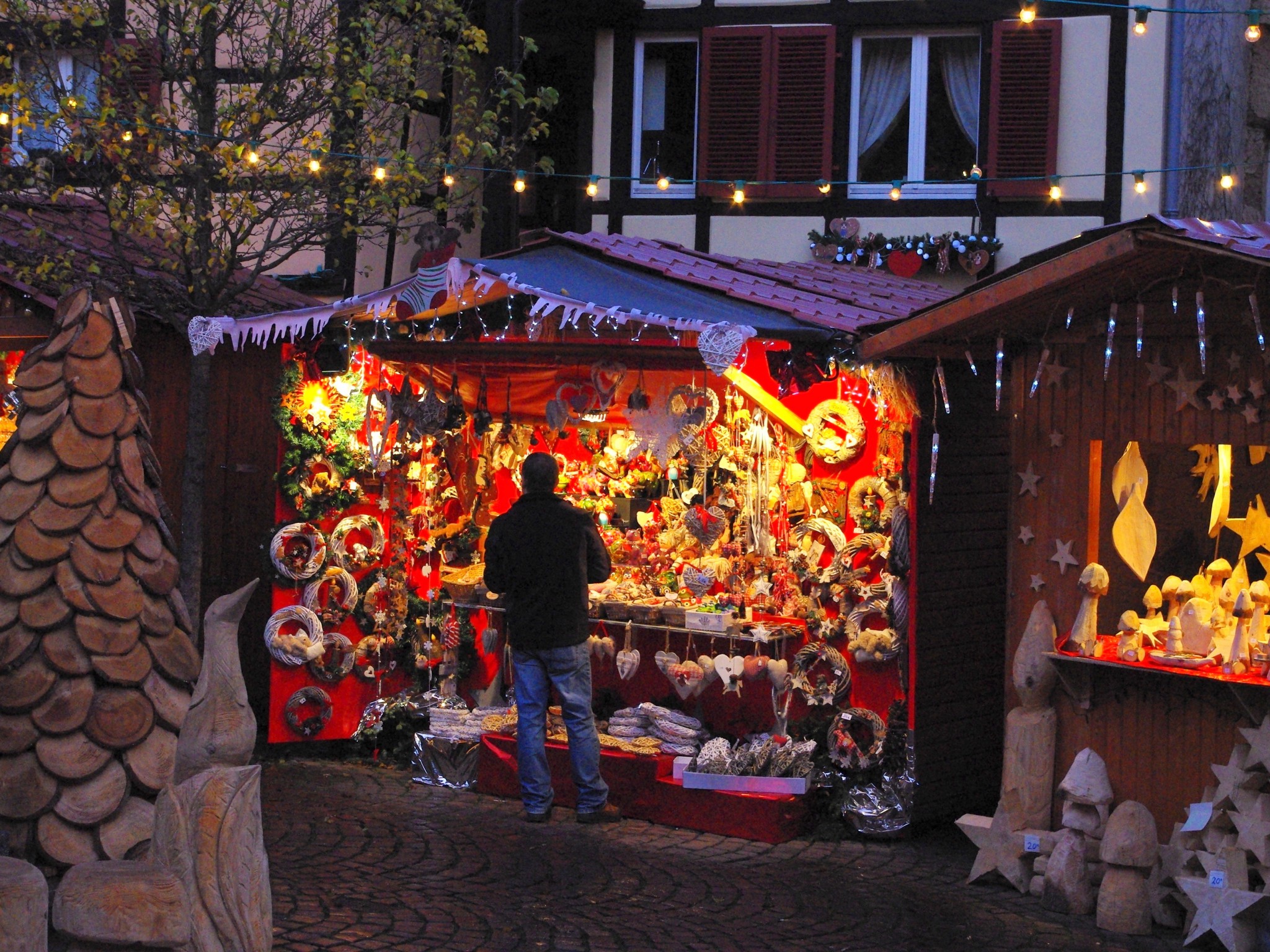
All French Christmas markets (marchés de Noël) find their origins in Alsace.
Indeed, the region’s proximity to Germany gives Alsatian and French Christmas markets a distinctly Germanic touch. This is apparent in the structure of the market stalls. These are little wooden houses resembling mountain chalets, covered in lights and decorations.
The oldest Christmas market in Europe is Strasbourg, which dates back to 1570.
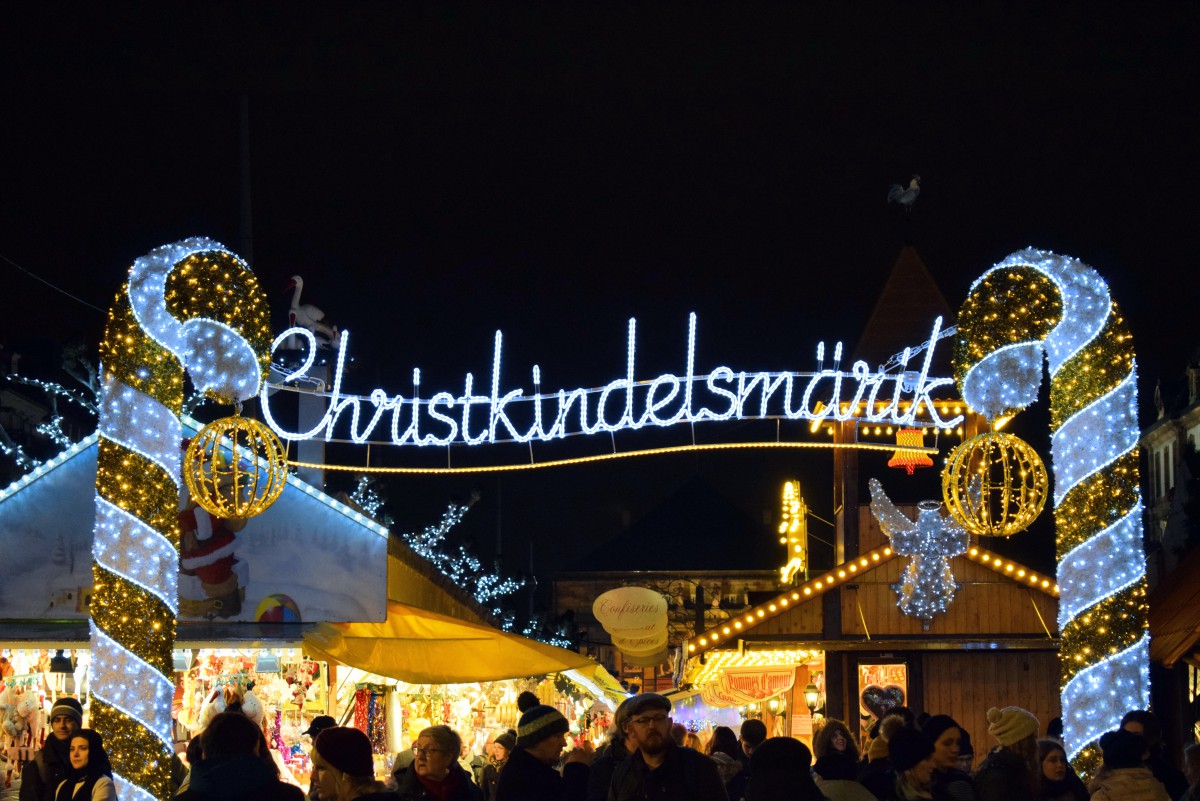
Christmas markets mainly sell Christmas products or sometimes Christmas gifts. But more recently, some would say there has unfortunately been a large amount of commercialisation of the idea of Christmas markets.
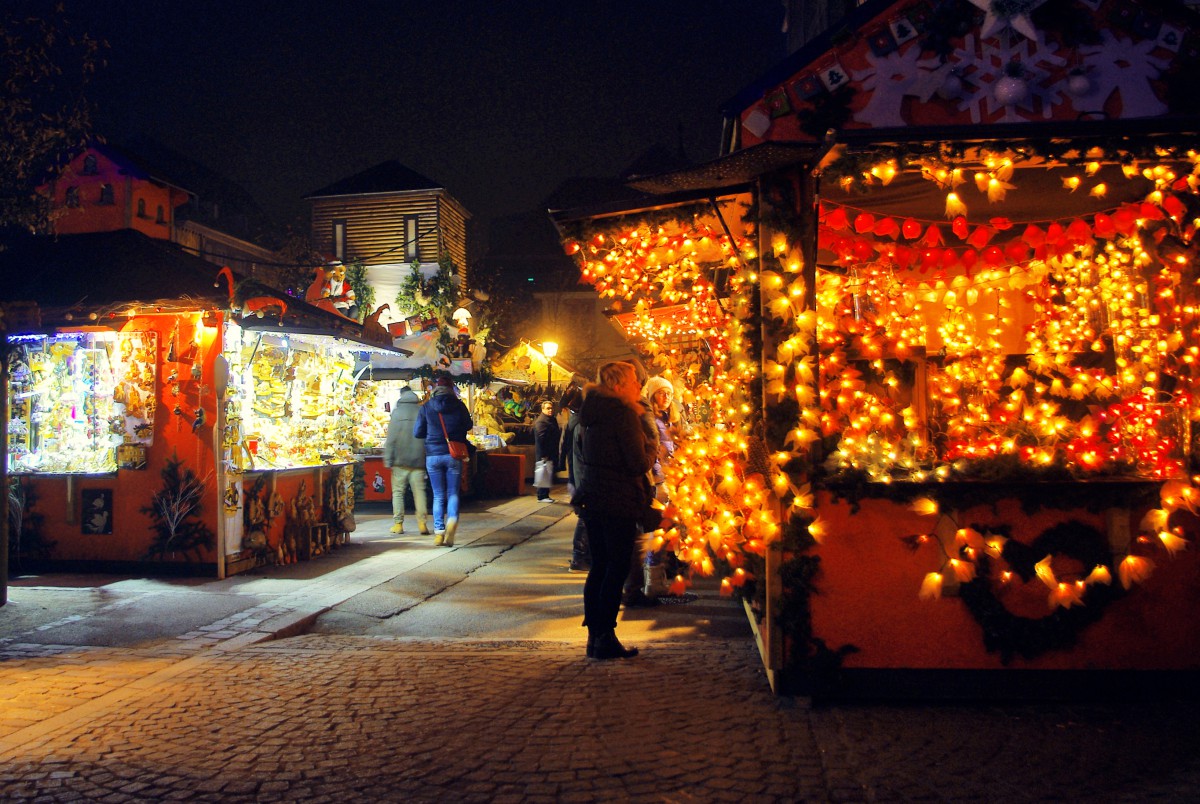
They can now be found all over France, with their distinctive wooden chalets. For example in Paris, Aix-en-Provence, Orléans, Besançon, Rouen, Dijon, Reims, Annecy, Grenoble, Lille, Arras, Béthune, Lyon, Nice, etc.
My favourite Christmas markets in France
What I like the most in a Christmas market is to experience the festive atmosphere. This is not just for getting ideas for presents. It is for the decoration and organisation that people put into it. Therefore I have my favourites! They are Christmas markets that I particularly like for their authenticity. Or for the careful attention to the chalets and product display. You’ll find most of them in Alsace and Lorraine. A few examples:
Strasbourg (Alsace)
The largest of all Christmas markets in France. As we said, it is one of the oldest in Europe. I love strolling from Place Broglié to the Petite France district via the Cathedral Square. I choose not to come on weekend days (to avoid the crowds of tourists!). Read more about Strasbourg at Christmas.
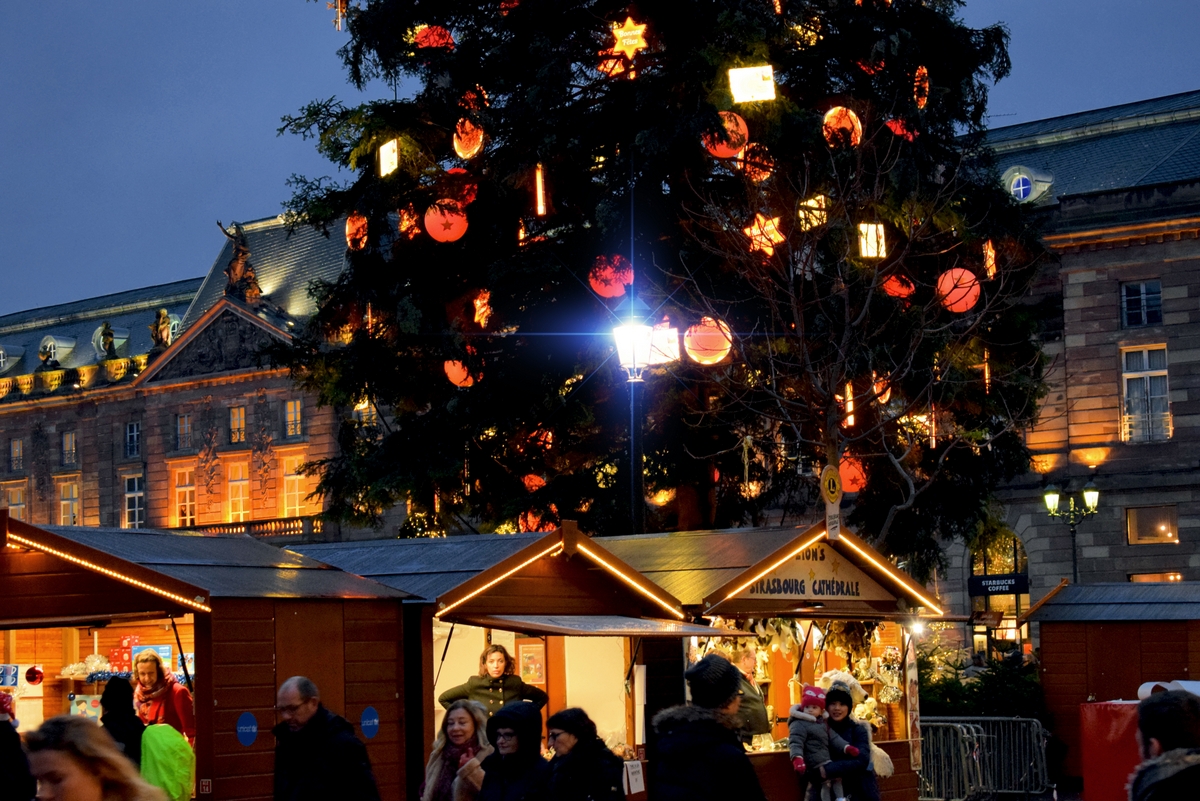
Colmar (Alsace)
The rich heritage of the town of Colmar is brilliantly enhanced with a festive (and vintage) Christmas light display. Read more about Colmar at Christmas.
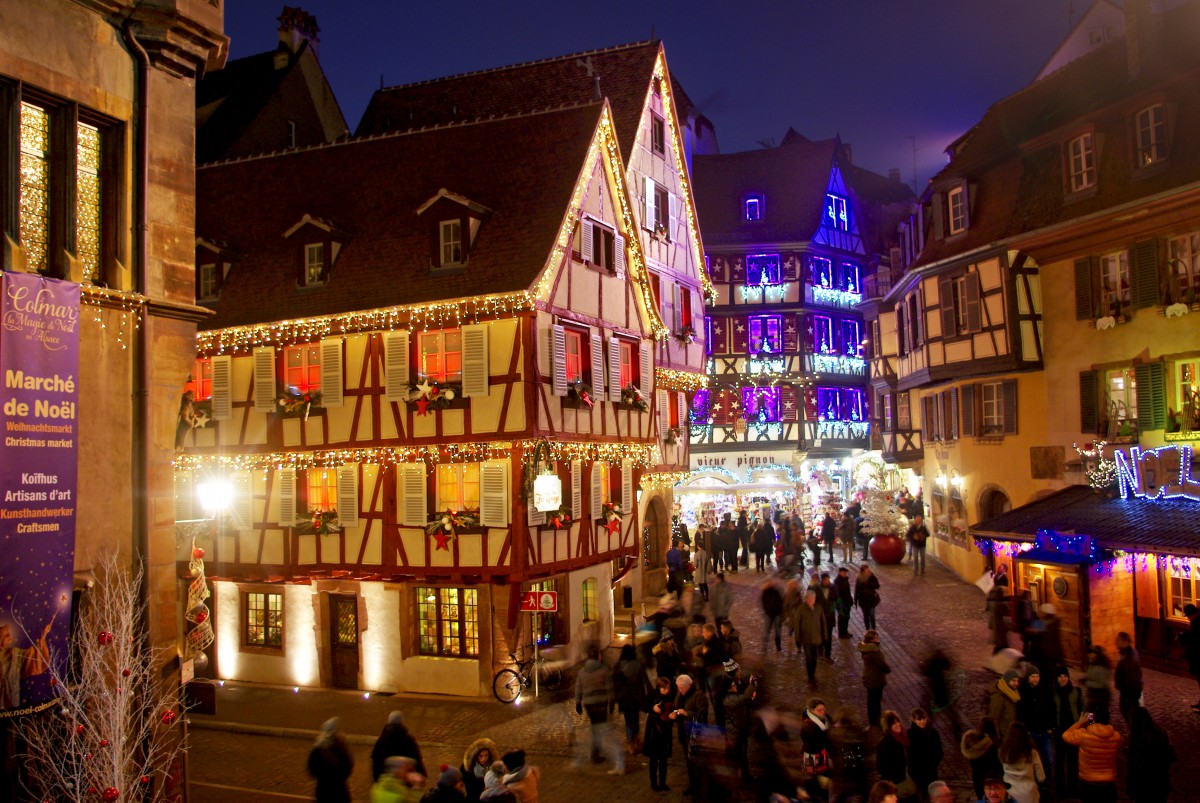
Mulhouse (Alsace)
The Place de la Réunion hosts an enchanting Christmas market. The protestant church of St. Etienne provides a spectacular backdrop to the market. Read more about Mulhouse at Christmas.
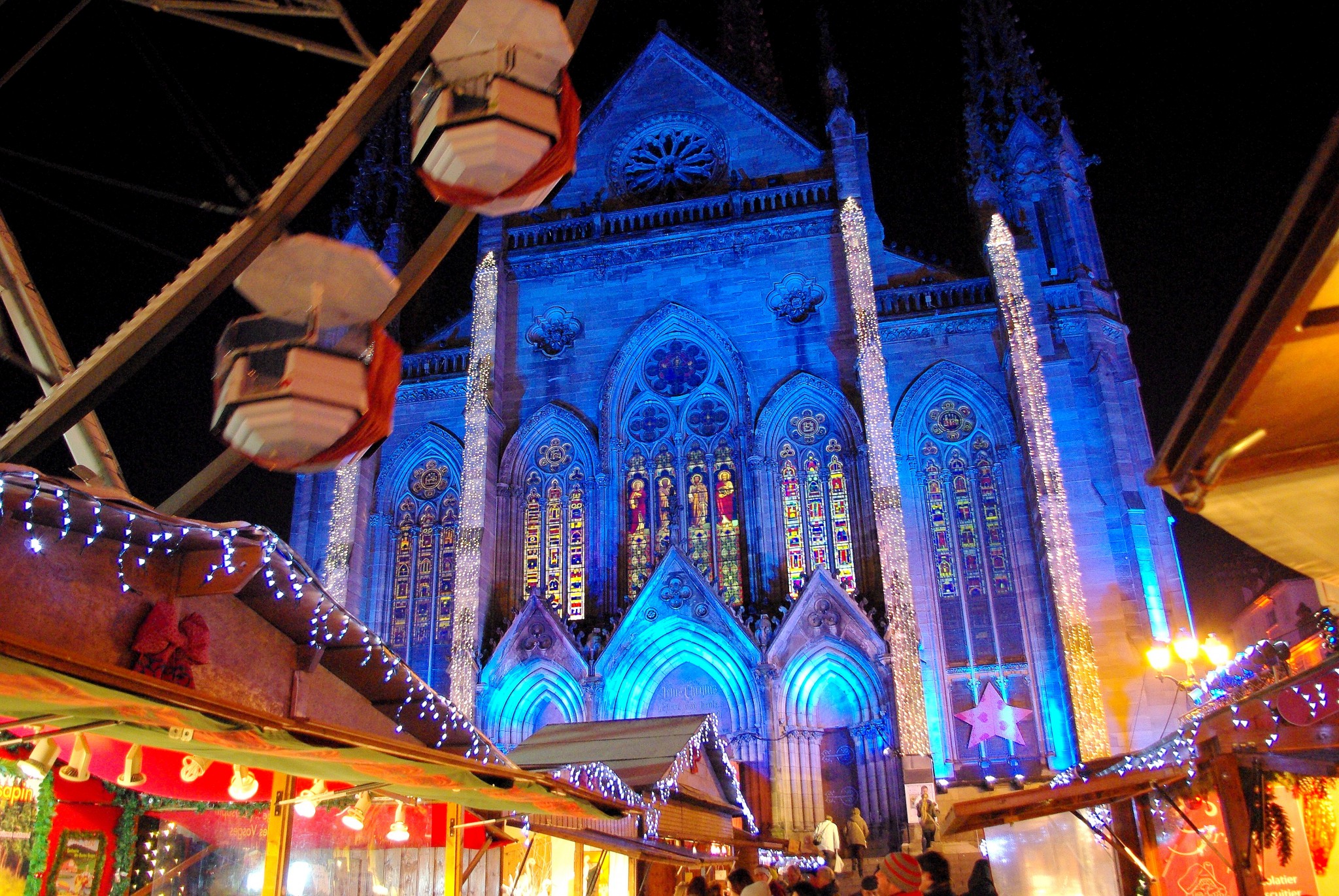
Kaysersberg (Alsace)
One of the most authentic Christmas markets in France! Kaysersberg is also one of our favourite spots in Alsace. Read more about Kaysersberg at Christmas.
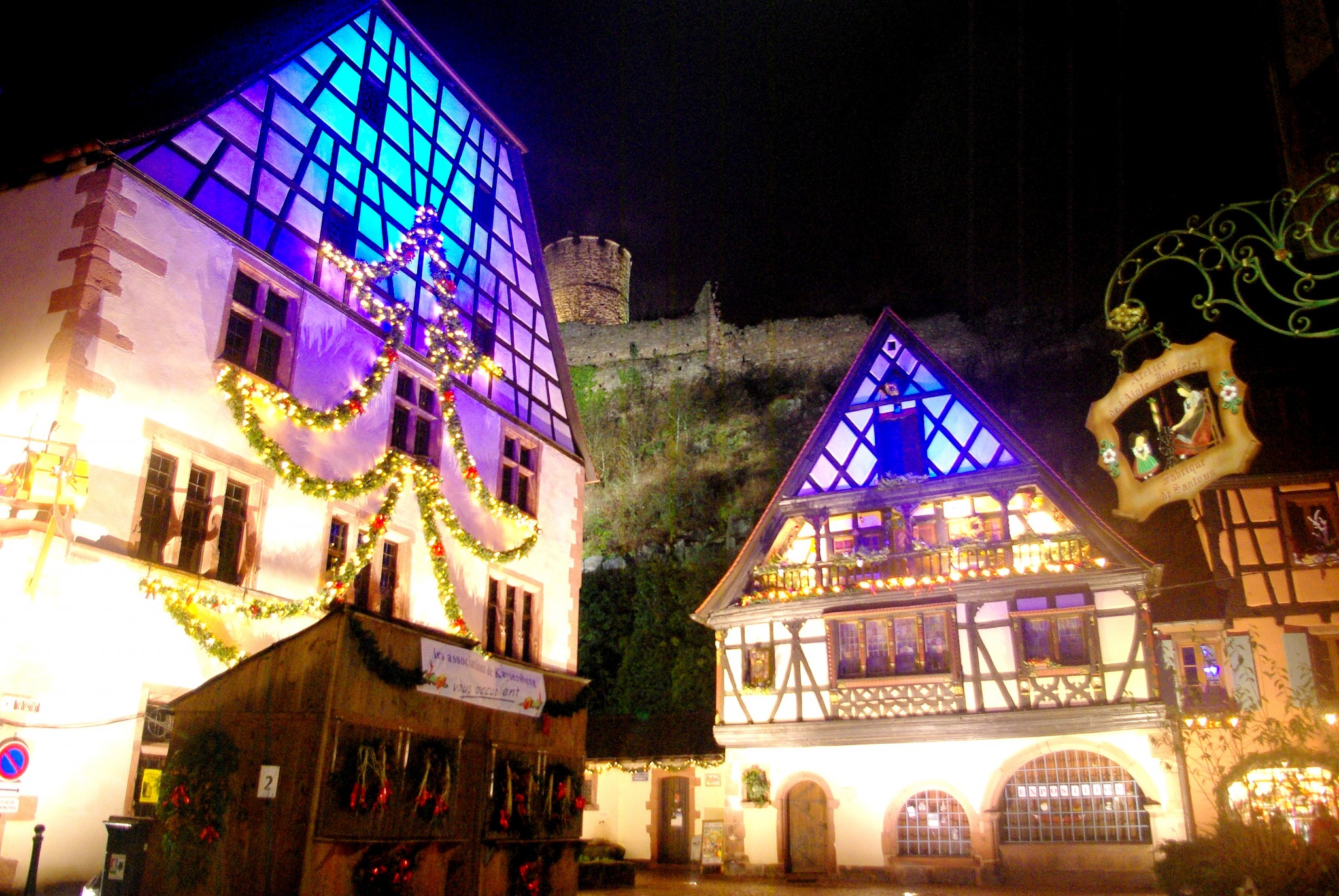
Eguisheim (Alsace)
The wine-growing village may host a tiny Christmas market, but it has a lot of charm. Read more about Eguisheim at Christmas.
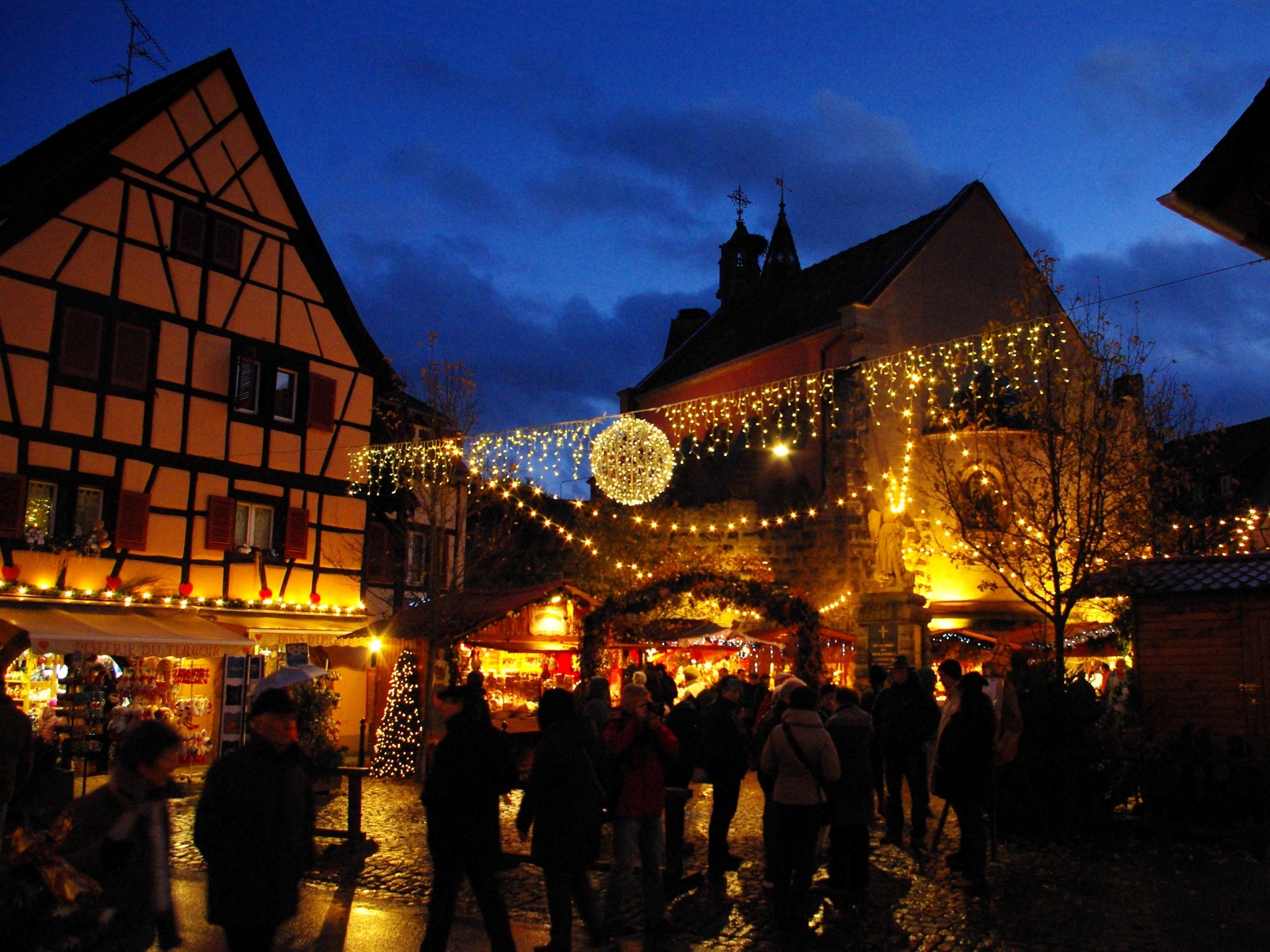
Sélestat (Alsace)
Sélestat is located in central Alsace, between Strasbourg and Colmar. The “cradle of the Christmas tree” boasts a rich architectural heritage. Read more about Sélestat at Christmas.
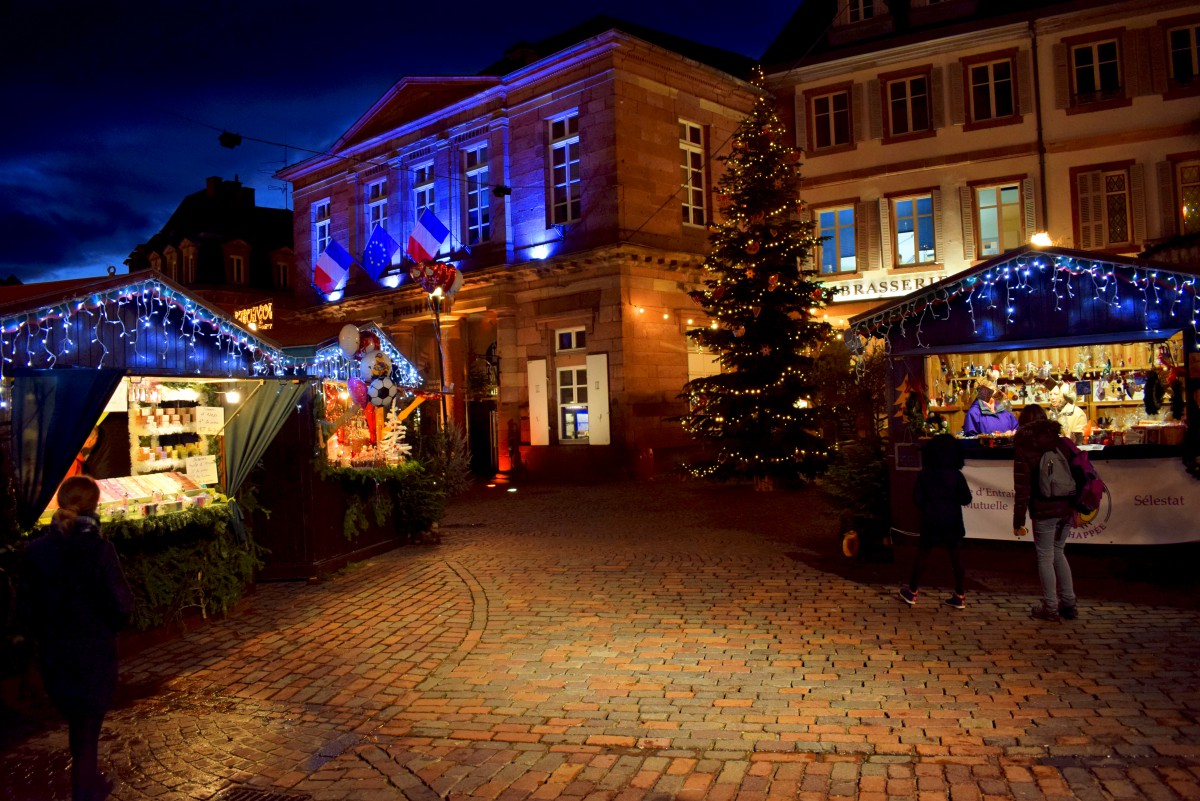
Obernai (Alsace)
The picturesque old town of Obernai specialises in a gastronomic Christmas market. The fine half-timbered houses that border the Place du Marché provide an enchanting scene for this festive event. Read more about Obernai at Christmas.
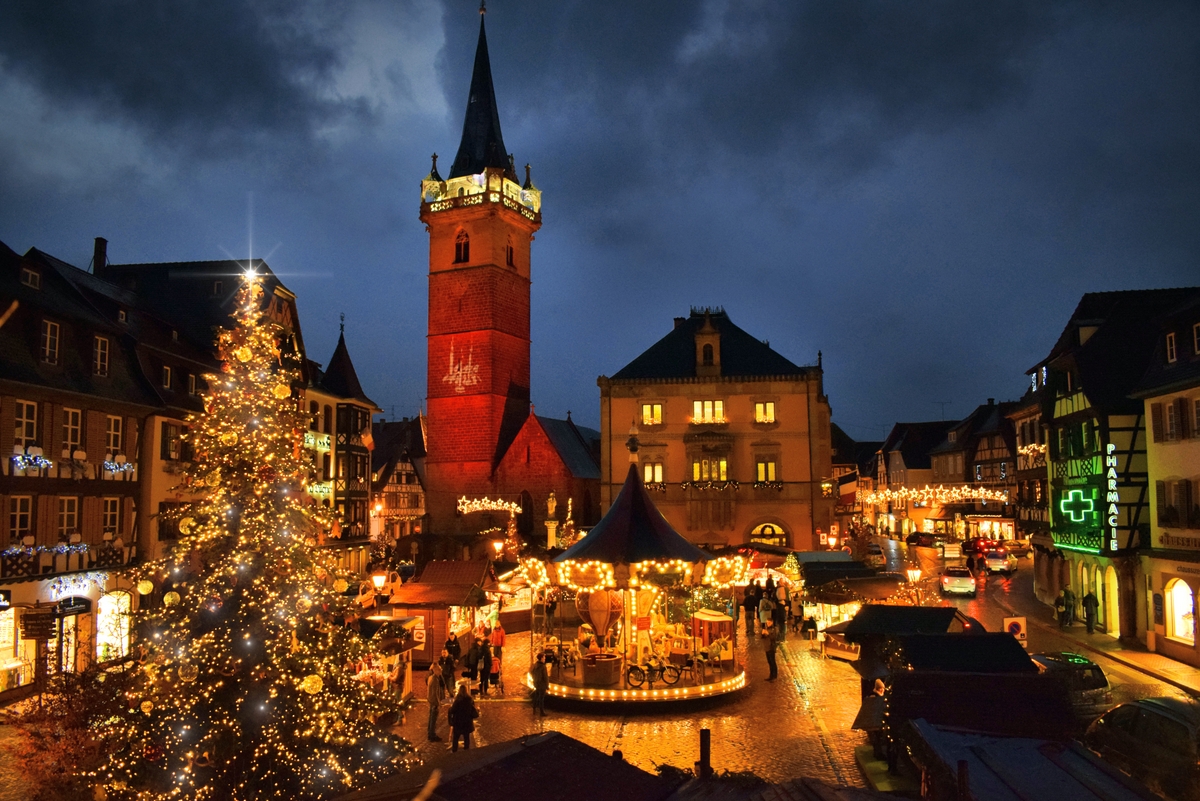
Haguenau (Alsace)
In northern Alsace, Haguenau organises a beautiful Christmas market during the whole festive period.
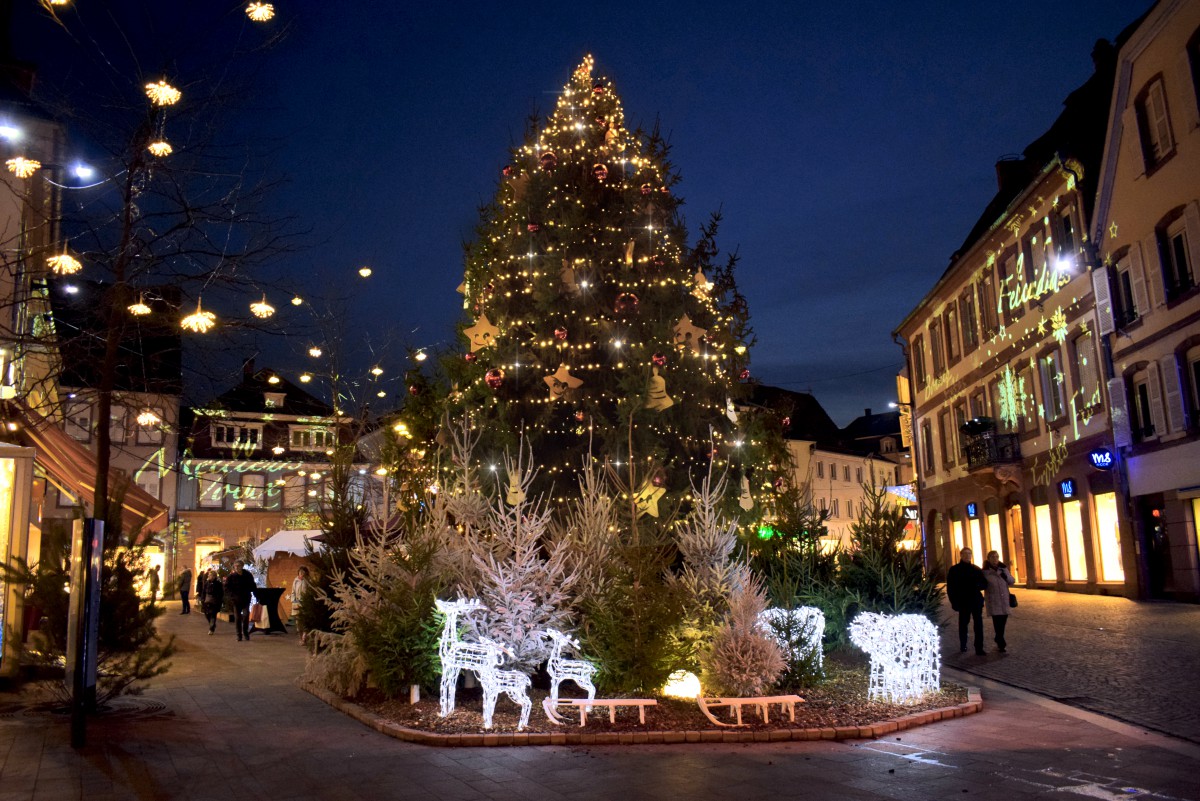
Wissembourg (Alsace)
Each year, the little town at the tip of Alsace chooses to respect the local traditions. Beware of Hans Trapp… fortunately, you’ll see the kind Christkindel not far away…
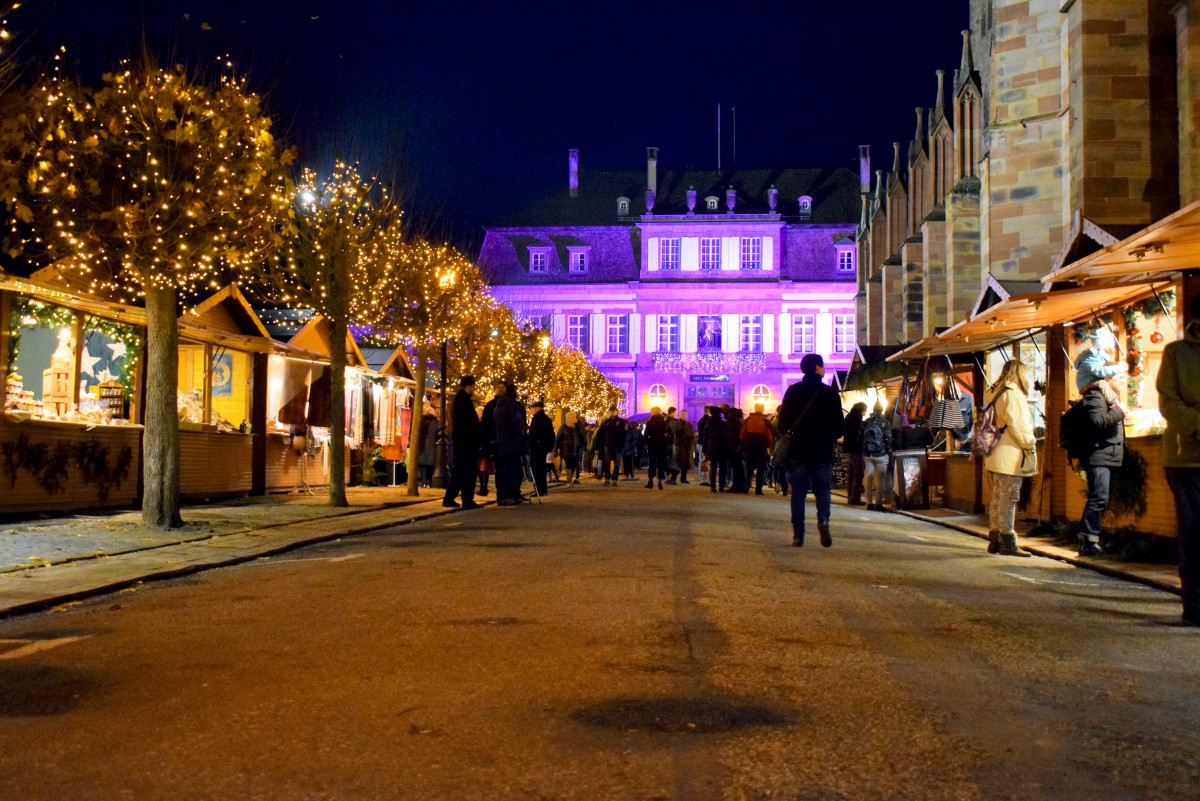
Metz (Lorraine)
The historic town hosts one of France’s largest Christmas markets after Strasbourg and Paris. Five different venues made up the Christmas market. My two favourites are the Place d’Armes (and its ferry wheel) and the medieval Place Saint-Louis. Read more about Metz at Christmas.
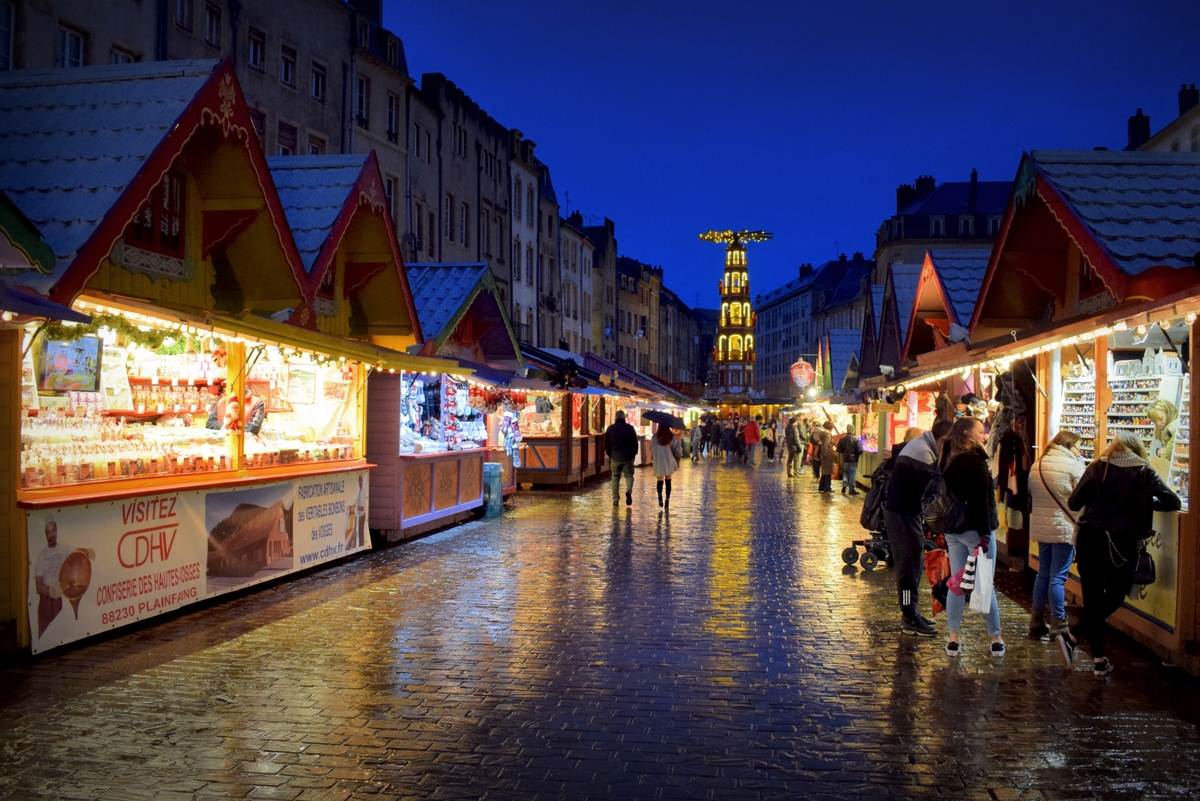
Nancy (Lorraine)
The festive market emphasizes the character of Saint Nicolas. The Unesco-listed Place Stanislas welcomes a superb Christmas tree while the Ferries wheel of Place de la Carrière offers a breathtaking town view. Read more about Nancy at Christmas.
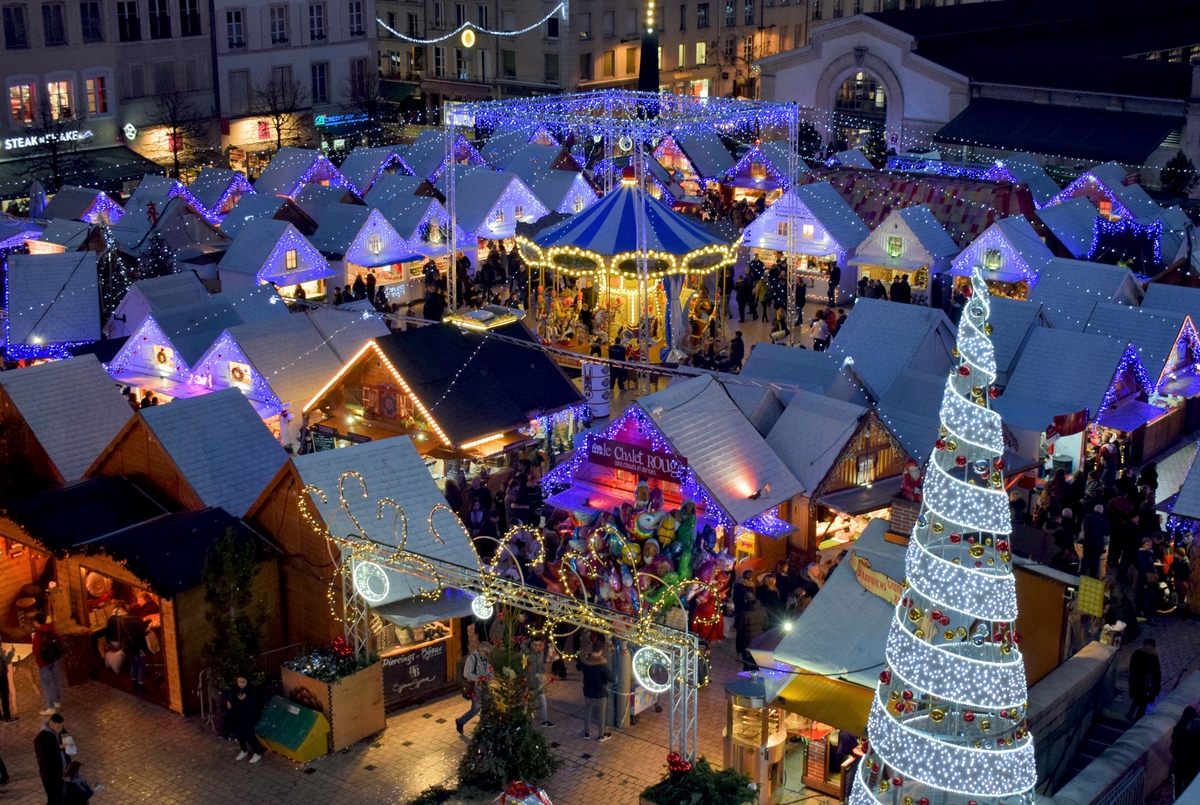
Montbéliard (Franche-Comté)
With its rich display of Christmas lights, Montbéliard is certainly one of the most beautiful Christmas markets I’ve ever visited! Read more about Montbéliard at Christmas.
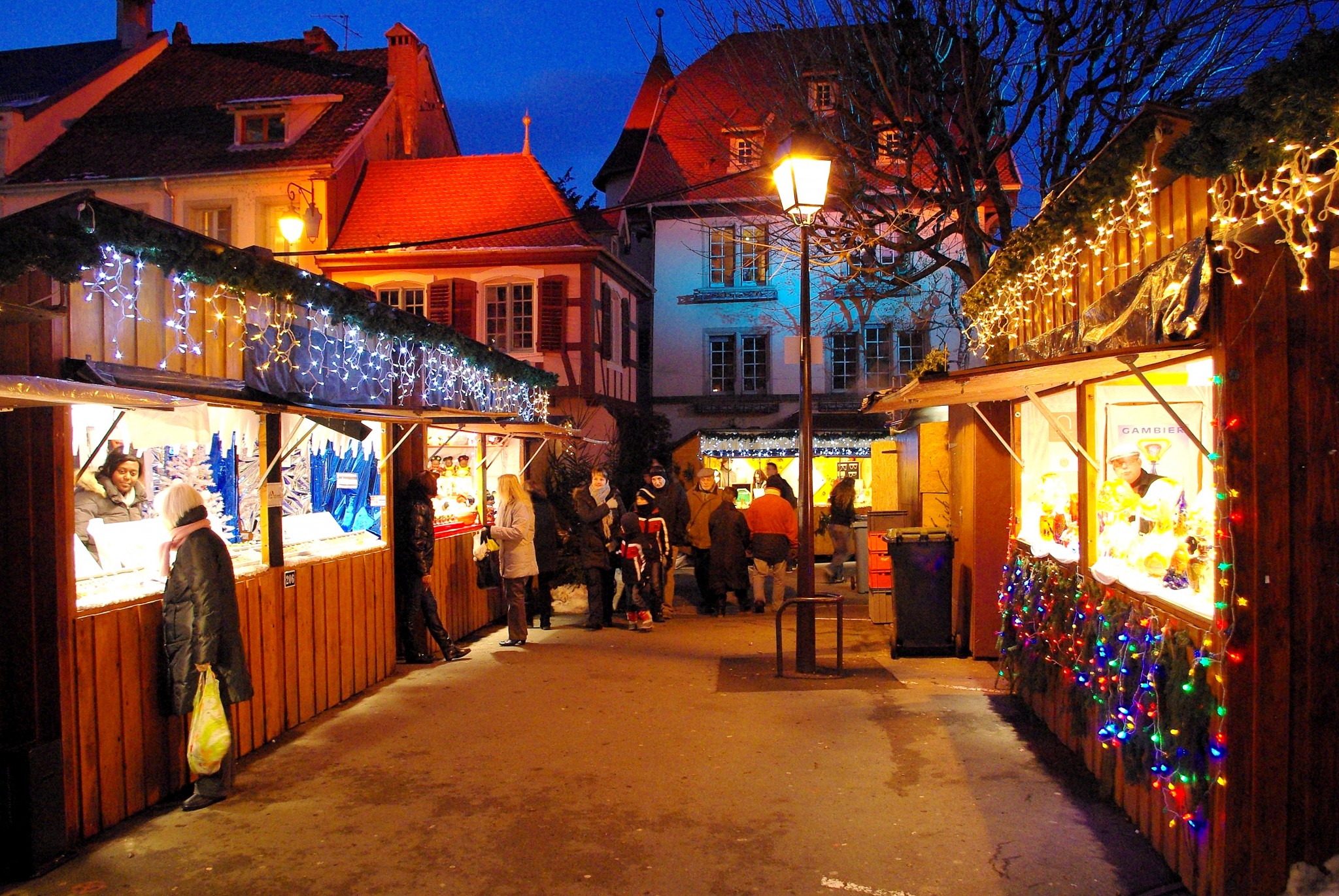
Annecy (Savoy)
You’ve probably heard about Annecy and its lake with turquoise water at the foot of snow-capped mountains. During the holidays, the historic town hosts a little Christmas market by the enchanting canals of the Venice of the Alps district. Simply amazing! Read more about Annecy at Christmas.
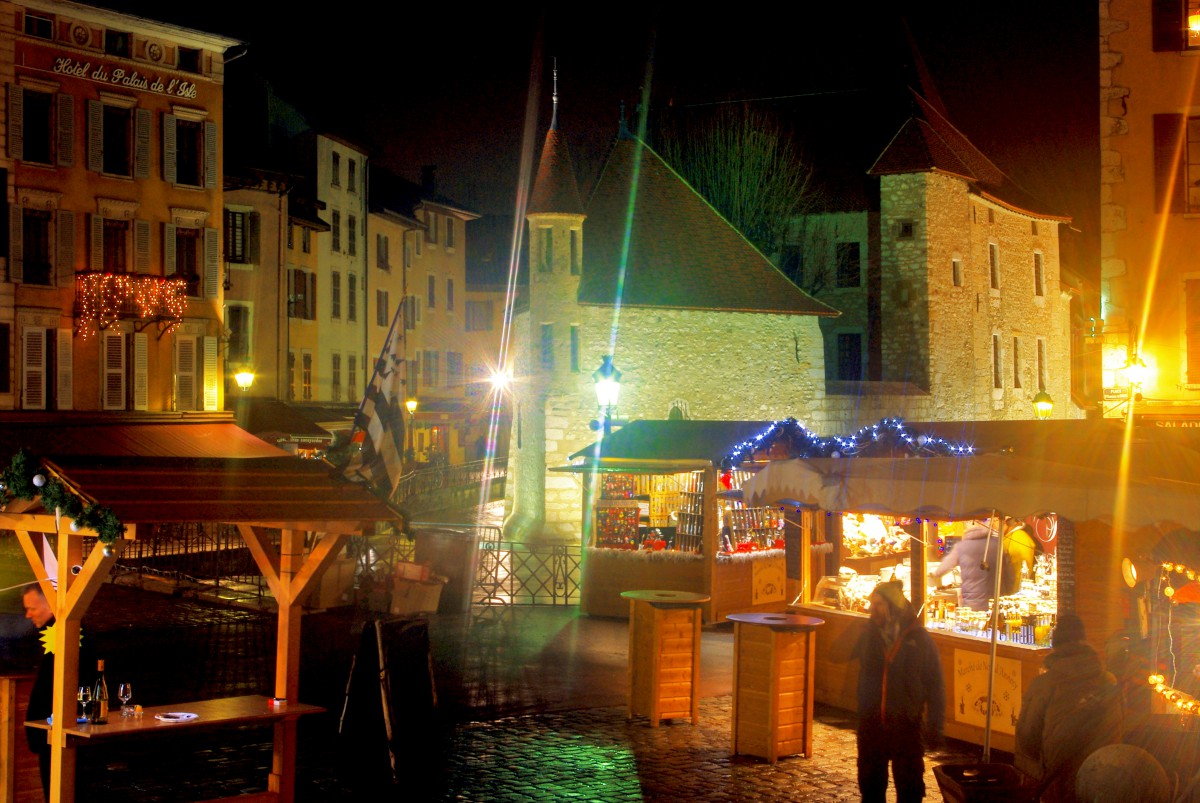
► Read more about the French traditions of Christmas in Alsace, Lorraine and Franche-Comté.
A Christmas stroll in Paris
Let’s put it that way: Paris is not my favourite place to be for its Christmas markets. I find them not as authentic as in Alsace. And particularly too commercial-oriented if I may say so!
However, there are several places I enjoyed visiting when I was in the French capital in December.
The Eiffel Tower sparkling at night
Popular spots to admire the Eiffel Tower sparkling are at the Trocadéro or from the Champ de Mars. I’ve found another beautiful spot, by the Debilly footbridge.
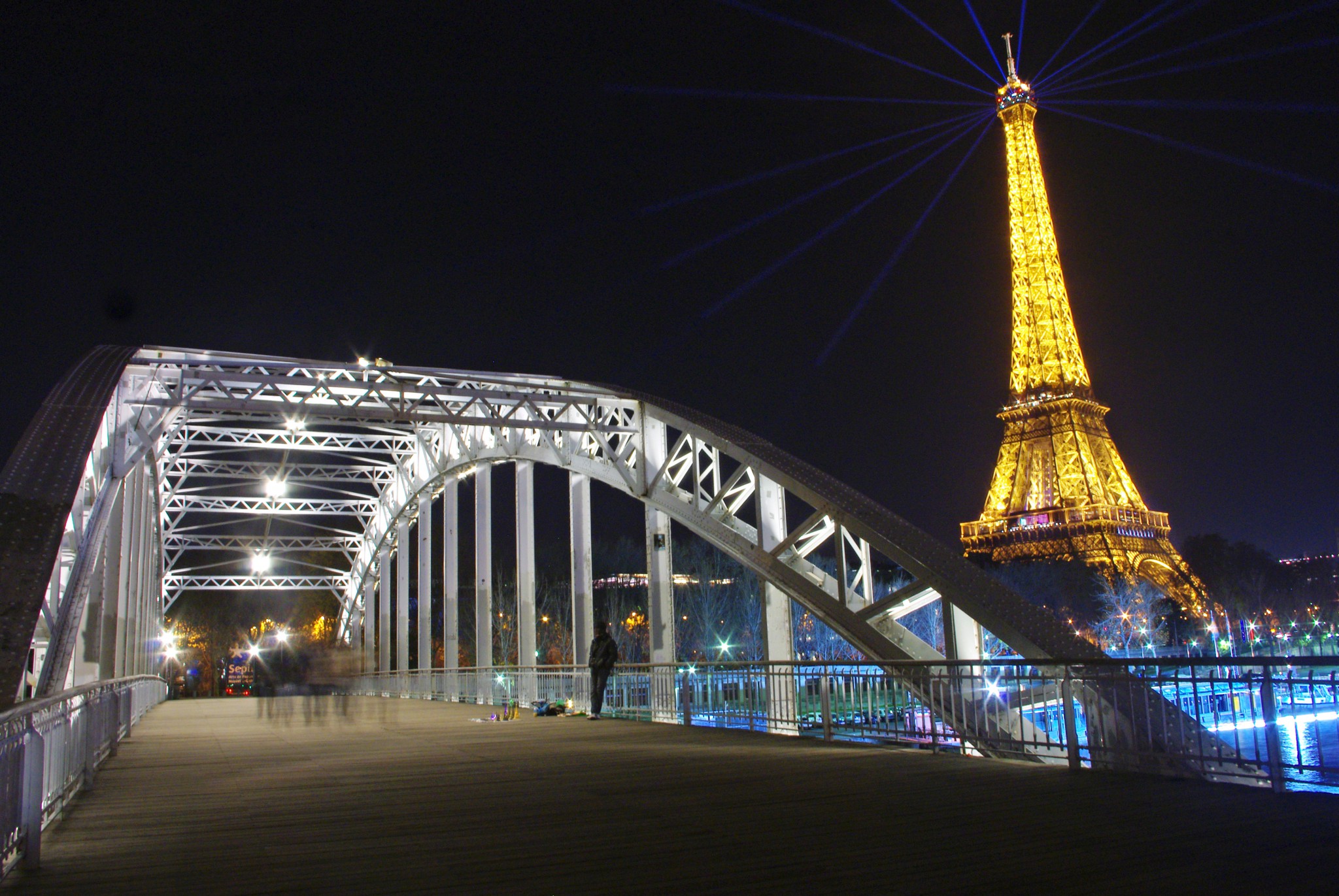
The Christmas lights at the Champs-Elysées
What a beautiful sight! Hundreds of thousands of LEDs illuminate the prestigious avenue from the Place de la Concorde to the Arc de Triomphe. Many consider the event the first observance of the French Traditions of Christmas.

The Nativity Scenes inside the churches of Paris
While living in Paris, I made it a tradition to enter the many churches to admire their Nativity Scenes. Some of them are simple settings; others are monumental. My favourite crib was that of Notre Dame… alas we’ll have to wait at least a couple of years before the end of the restoration work.

Montmartre by night
I enjoy Montmartre by night when the streets are deserted. Past 6 or 7 pm on a weekday in December, the charming square of Place du Tertre is relatively empty and offers a beautiful sight of Sacré-Cœur all lit up.

The Banks of the River Seine
Paris may look grim on a grey winter day. But wait for the night to fall, and the magic begins! I love strolling by the banks of the River Seine at night time for all the lights and monuments to see. My favourite itinerary starts from Pont de Sully and ends at the Place de la Concorde.

Read more about the French traditions of Christmas in Paris.
The Christmas lights in the North-East of France
Apart from Paris, the City of Lights, one has to get to the North-East of France to discover the lights of Christmas. The “Lumières de Noël” are inextricably related to the Christmas markets of Alsace and Lorraine. However, many villages that do not host a Christmas market would have strings of light decorating the streets. And often, a glittering Christmas tree stands on the main square.
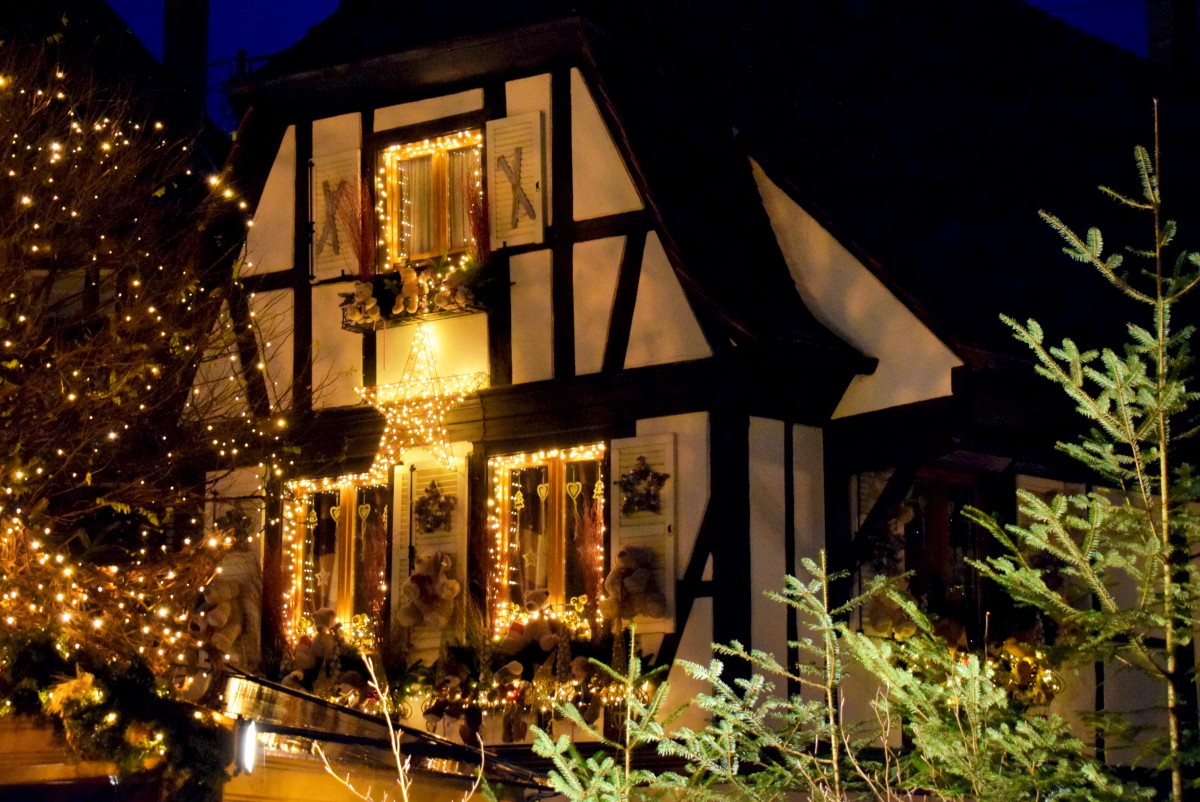
Main cities of France would decorate their streets with repetitive and plain Christmas decorations. In Alsace, tradition has it that the Advent period is the moment to express one’s decorative skills.
There are numerous examples of places to see Christmas lights in Alsace and Lorraine.
Here are some ideas for a visit:
Strasbourg, Alsace
Nicknamed the “Capital of Christmas”, Strasbourg is no stranger to an abundance of lights and decorations. Head to the narrow Rue des Orfèvres and Rue du Maroquin near the cathedral. The picturesque district of La Petite France is also a great place to visit.
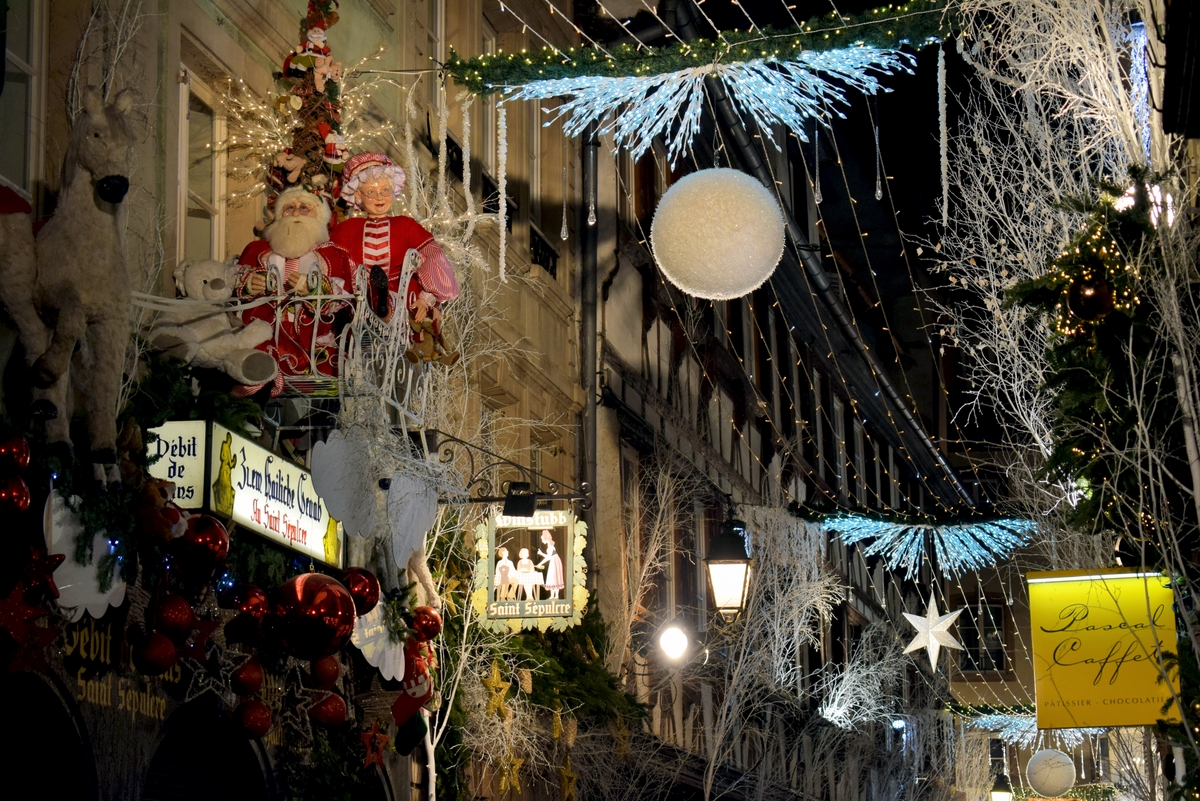
Find out more about Christmas in Strasbourg
Wissembourg, Alsace
It’s one of my favourite places to be at Christmas time! The little town of Wissembourg, at the northern tip of Alsace, wants to show us what it means to celebrate Christmas according to the local traditions. What a beautiful atmosphere!

Saverne, Alsace
The Christmas market in Saverne is not particularly big. One of the reasons must be the proximity of Strasbourg. Therefore, each year, Saverne hosts a Christmas event called “Féerie d’Hiver” (Winter Wonderland). It features an incredible light display on the façades of the entire main street.
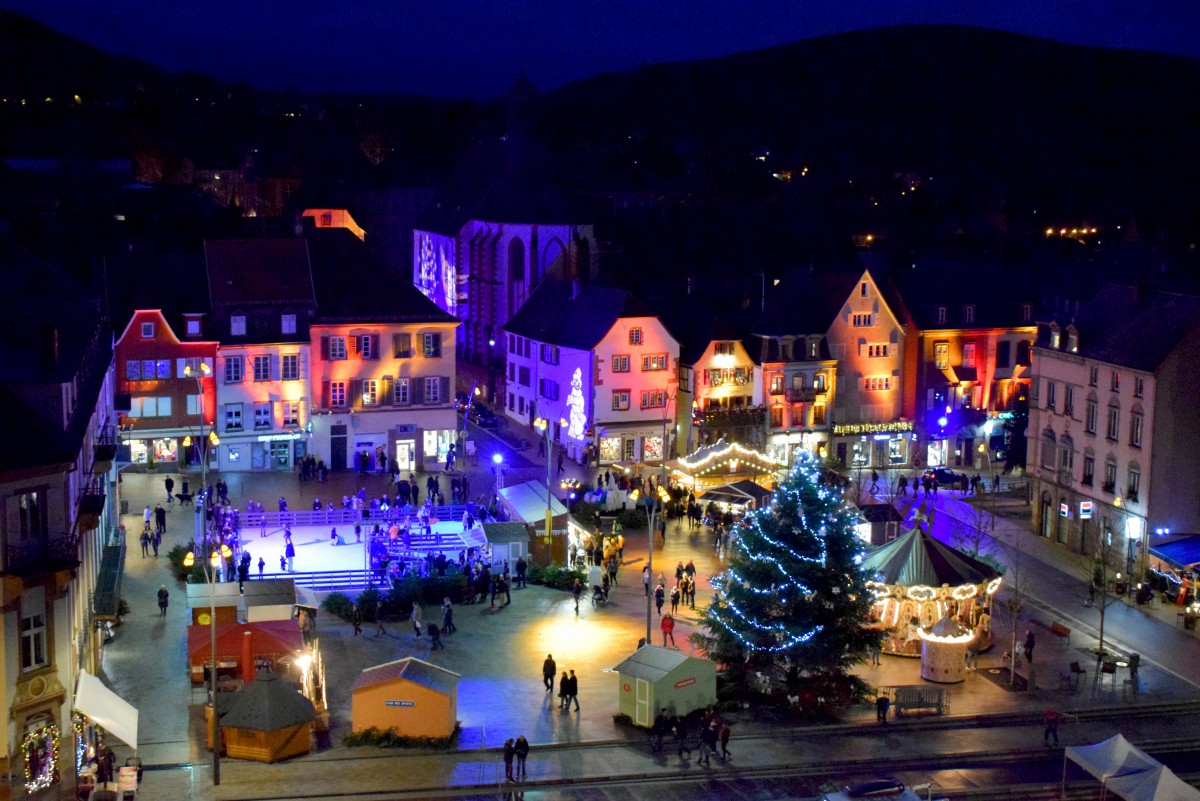
Sélestat, Alsace
Between Strasbourg and Colmar, Sélestat takes pride in being the first place where a decorated Christmas tree was mentioned. Therefore, the little town plays the Christmas tree card very well with many lights.
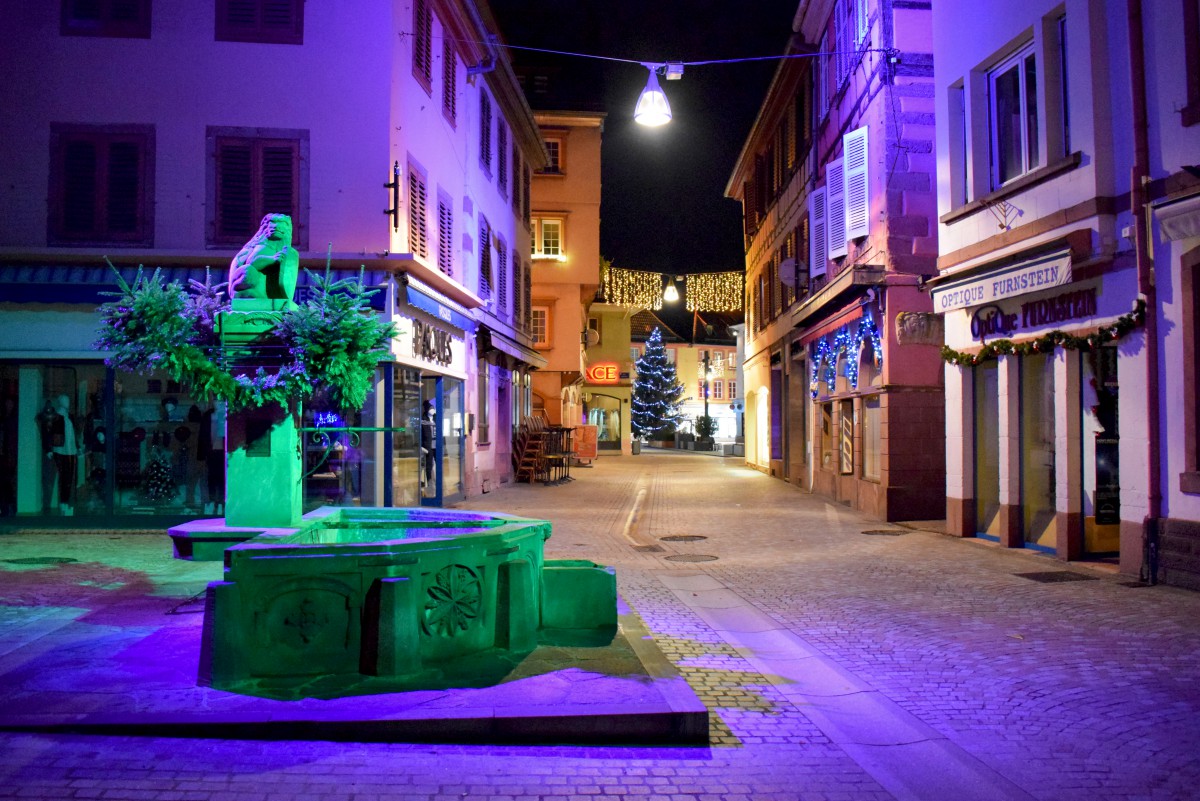
Find out more about Christmas in Sélestat
Ecomusée d’Alsace
Europe’s largest open-air museum reopens during Advent for the joy of young and old! The reconstituted Alsatian village with its half-timbered houses is beautifully decorated with Christmas trees everywhere!
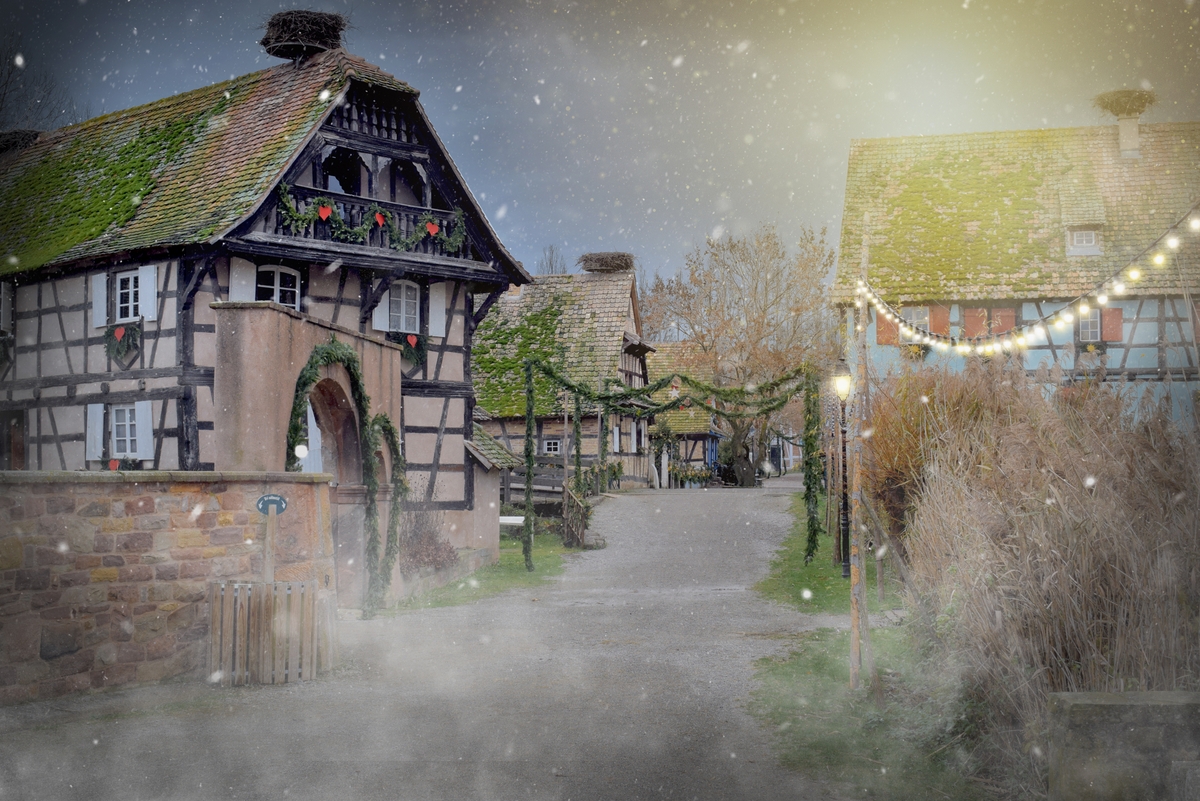
Find out more about the Ecomusée d’Alsace
Nancy, Lorraine
I think Nancy would have to be the most elegant place in the northeast of France to spend Christmas. The royal square of Place Stanislas is adorned with a giant Christmas tree. The main street of the old town is also a must-see.
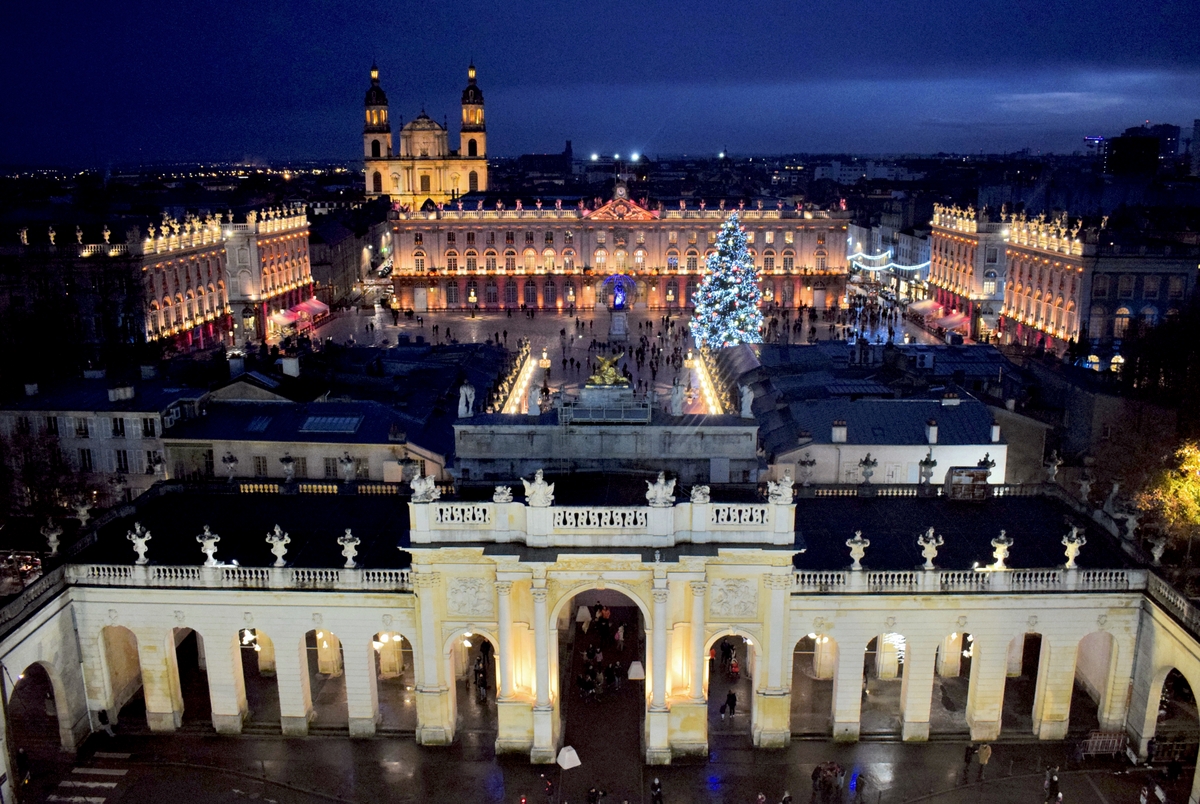
Find out more about Christmas in Nancy
Metz, Lorraine
North of Nancy, the Lorraine city of Metz has become a Christmas hotspot thanks to its brilliant Christmas market. But there are other Christmas lights, such as the Trail of Lanterns.
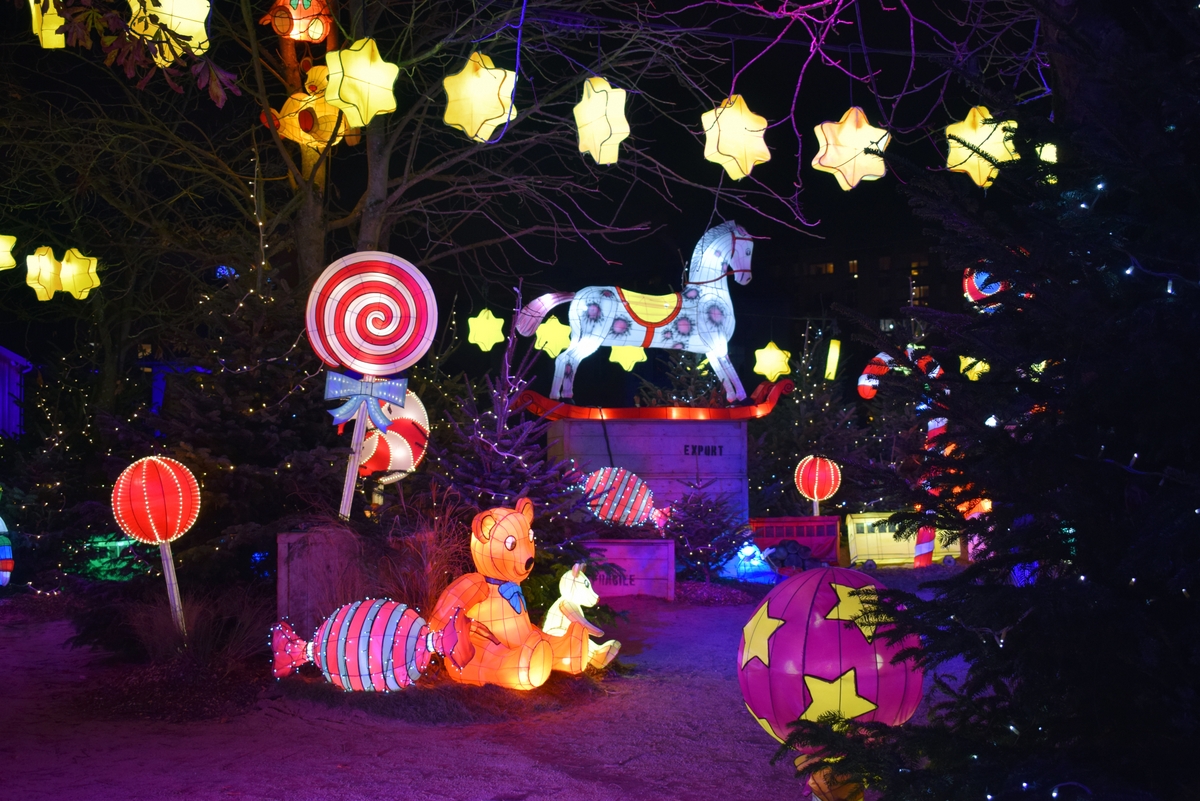
Find out more about Christmas in Metz
Montbéliard, Franche-Comté
The town of Montbéliard lies in the Franche-Comté region but is very close to Alsace. Its Holiday time is locally known as “Lumières de Noël” (Christmas lights).
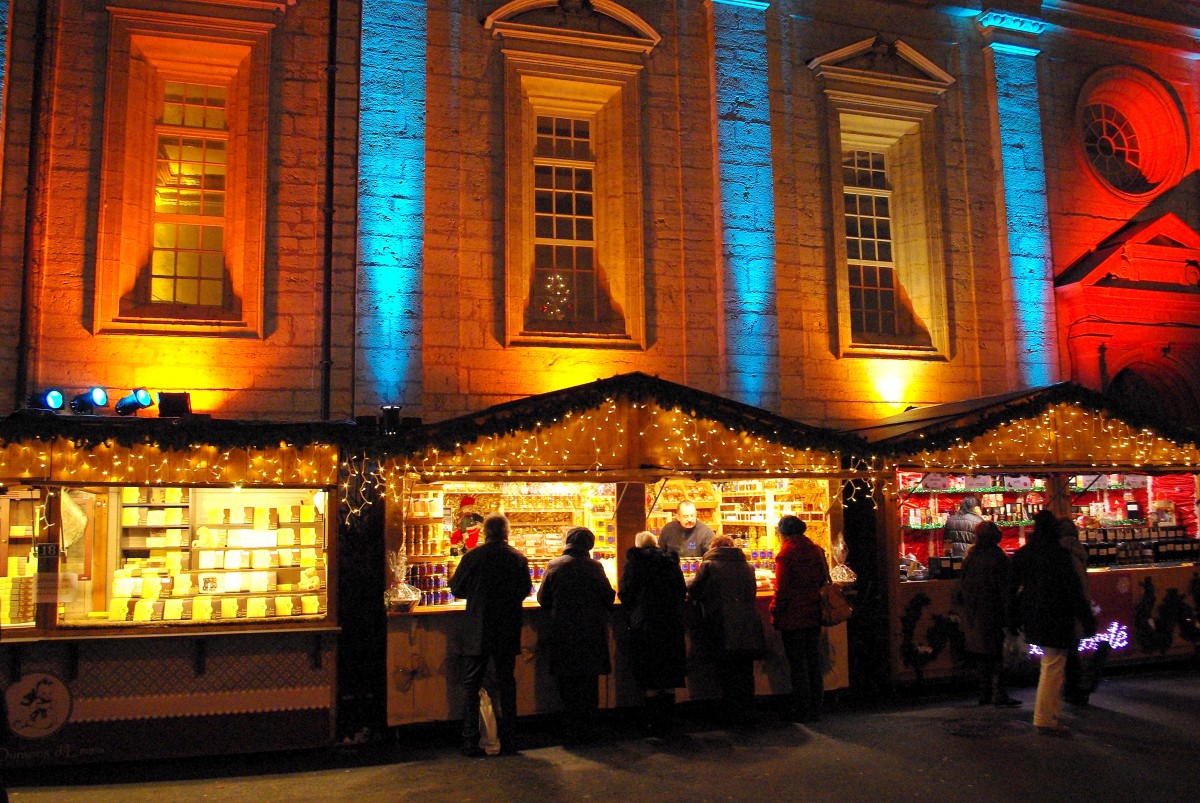
Find out more about Christmas in Montbéliard
The colours of Christmas
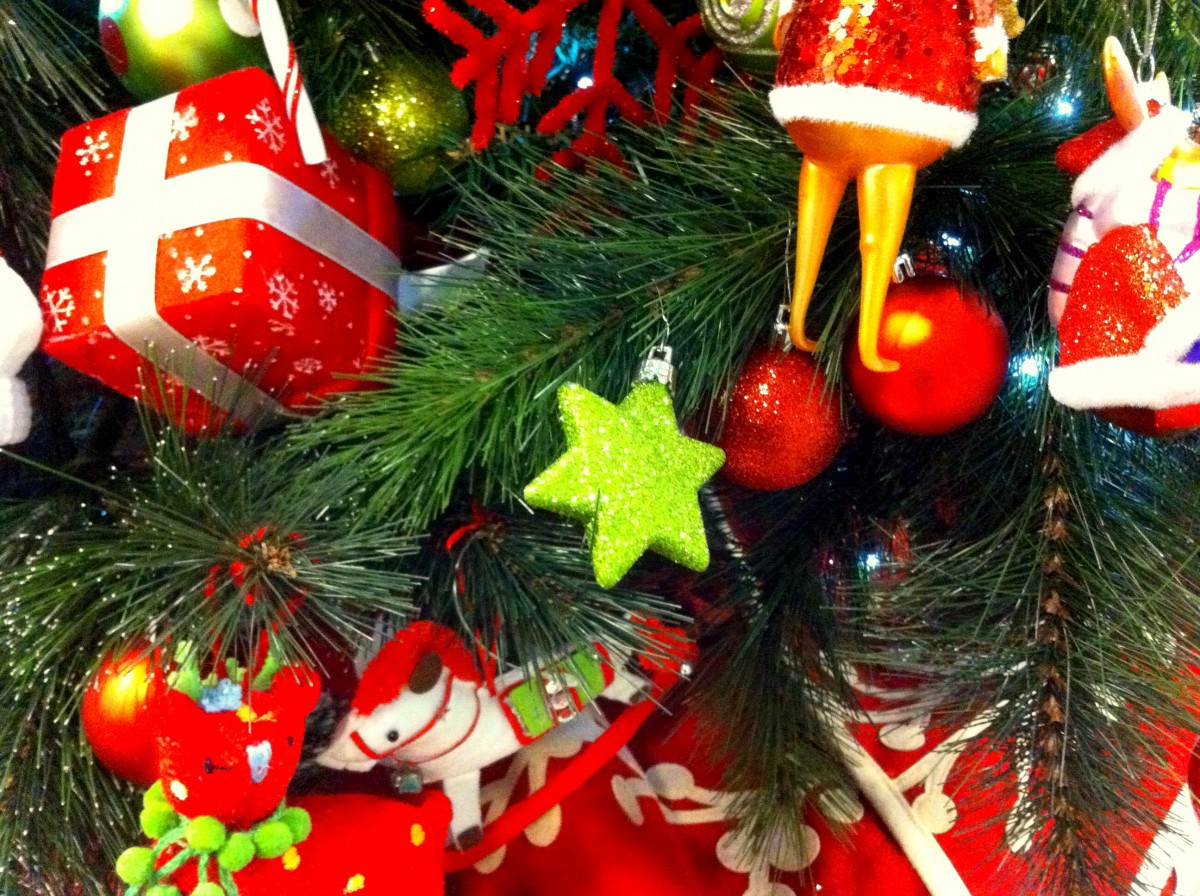
The traditional colours of Christmas (couleurs de Noël) are red, gold and green:
- The flamboyant colour red evokes light and warmth (as well as Santa’s outfit).
- Gold refers to the sun, which is not often visible in Northern France in December.
- Green is a reminder of the evergreen trees, such as figs and holly, which are … always green. This is regardless of the season or time of year. It is the colour of hope, paired with the knowledge that spring will eventually return!
The Poinsettia flower

As in Northern America and England, the poinsettia flower (Euphorbia pulcherrima) is widely used in Christmas floral displays, especially in Alsace.
The Central American indigenous plant is appreciated for its red and green foliage that recalls the traditional colours of Christmas. The poinsettia initially grew in Mexico, where it was known as the “Flower of the Holy Night”. Joel Poinsett first brought it to America in 1829. Unsurprisingly, he gave his name to the flower!
The flower is also known in French as “étoile de Noël” for its star-shaped leaf pattern. The flower symbolises the Star of Bethlehem, while the red represents Jesus’s blood sacrifice at the crucifixion.
Mistletoe and holly
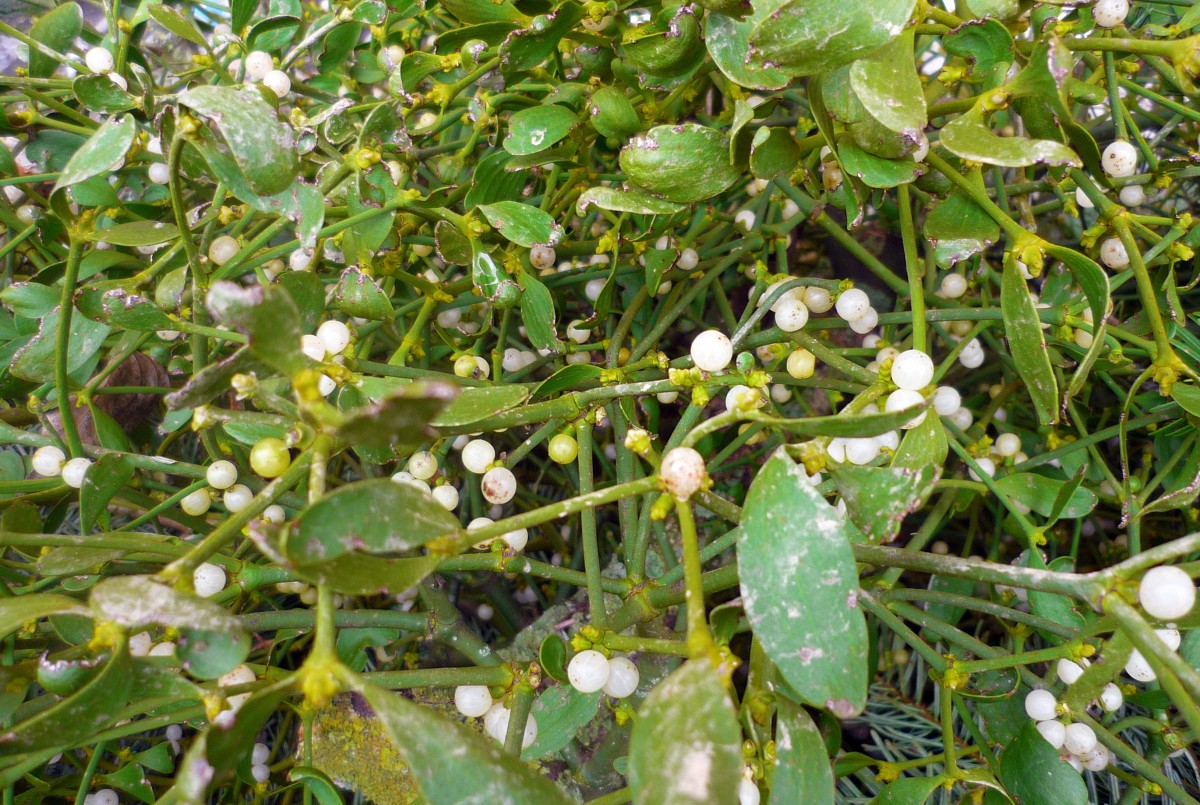
In France, mistletoe (gui) is not only used for New Year’s Eve. It is also hung above the door, on beams and luminaries during Christmas. It was to bring good fortune throughout the coming year.
Pine cones (painted gold), walnuts and holly (houx) are also widely accepted symbols of Christmas.
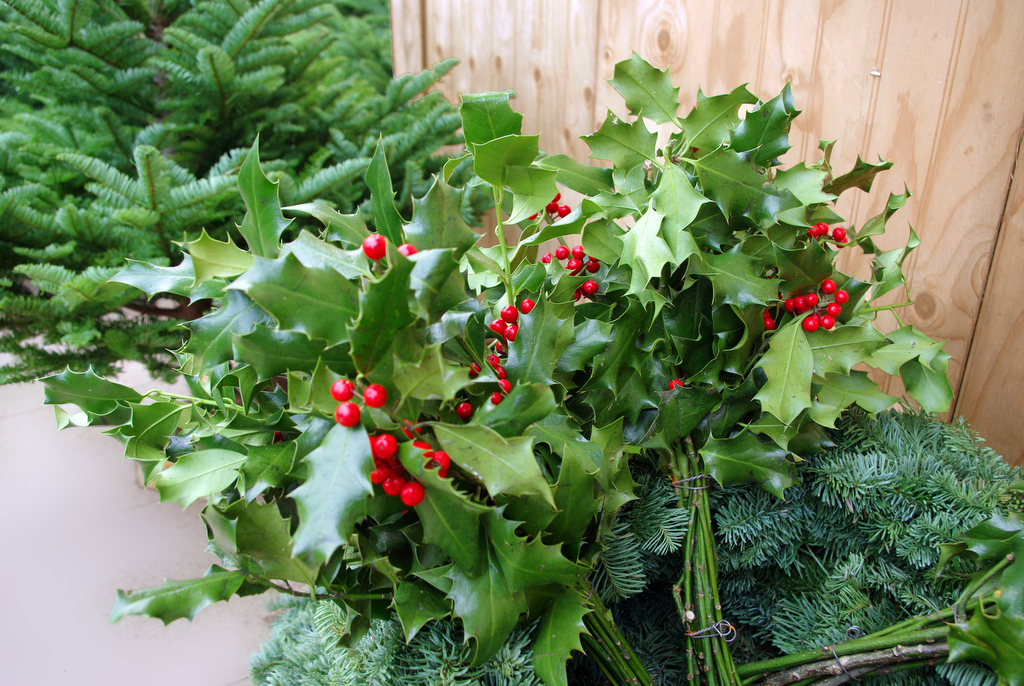
The legend goes that when Jesus and his family fled Egypt, the soldiers of Herod were about to catch them. The holly (le houx) extended its branches to hide Jesus and his parents. Mary thus blessed the holly. In doing so she announced that it would remain eternally green, a symbol of hope and immortality.
Exchanging vows
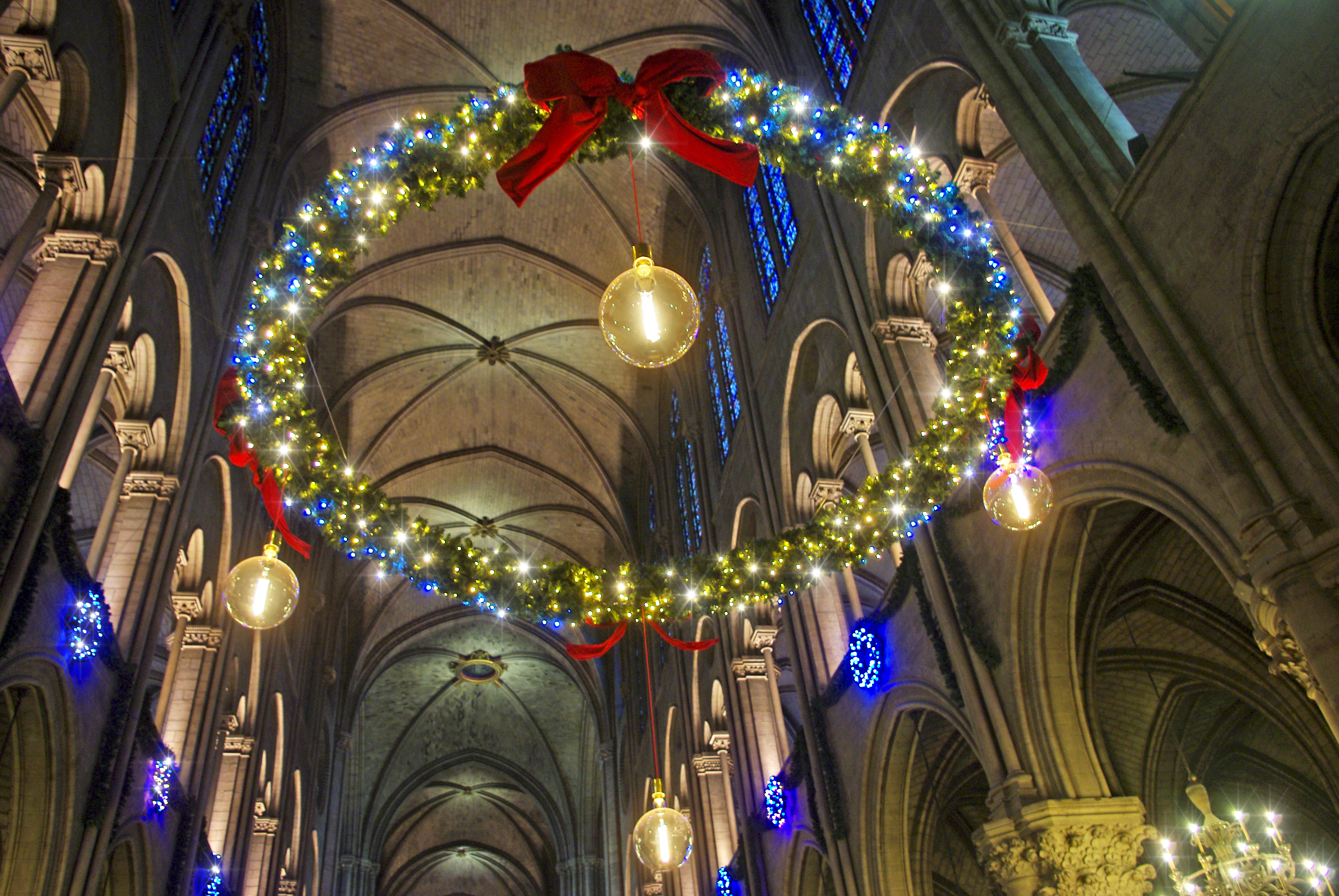
Exchanging vows for Christmas and the New Year (vœux) has been practised between neighbours for centuries in France. However, with the invention of postal mail, the practice became more widespread. Nevertheless, it is still not a tradition as important as it is in other countries such as England.
Read more about New Year’s Eve in France.
Christmas in Alsace – a Photographic Journey
I’ve released my new eBook: Christmas in Alsace – a Photographic Journey.
It contains 340+ photos, 256 pages and covers 16 destinations.
Illuminations, decorations, fir trees and delicious treats: this is a compilation of things I loved and experienced while visiting Alsace in December.
These are photos shot during freezing nights in December… but also in the warm atmosphere of an authentic Christmas market.
It is a book dedicated to discovering the Christmas traditions that make Alsace such a unique holiday destination.
I hope it will transport you somewhere special – to a magical land far from all the bad news in the media.
Pin it on Pinterest!
If you liked reading this article about the French traditions of Christmas, pin this picture for later!
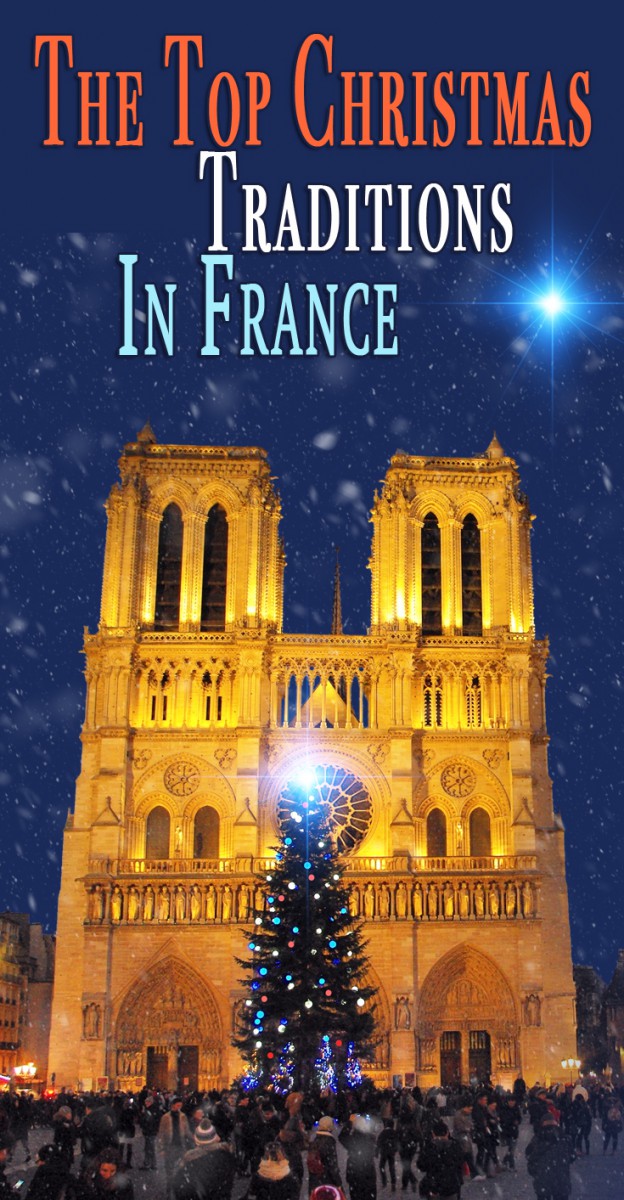
Want to read about the French traditions of Christmas in French? Check out our article on the blog Mon Grand-Est!

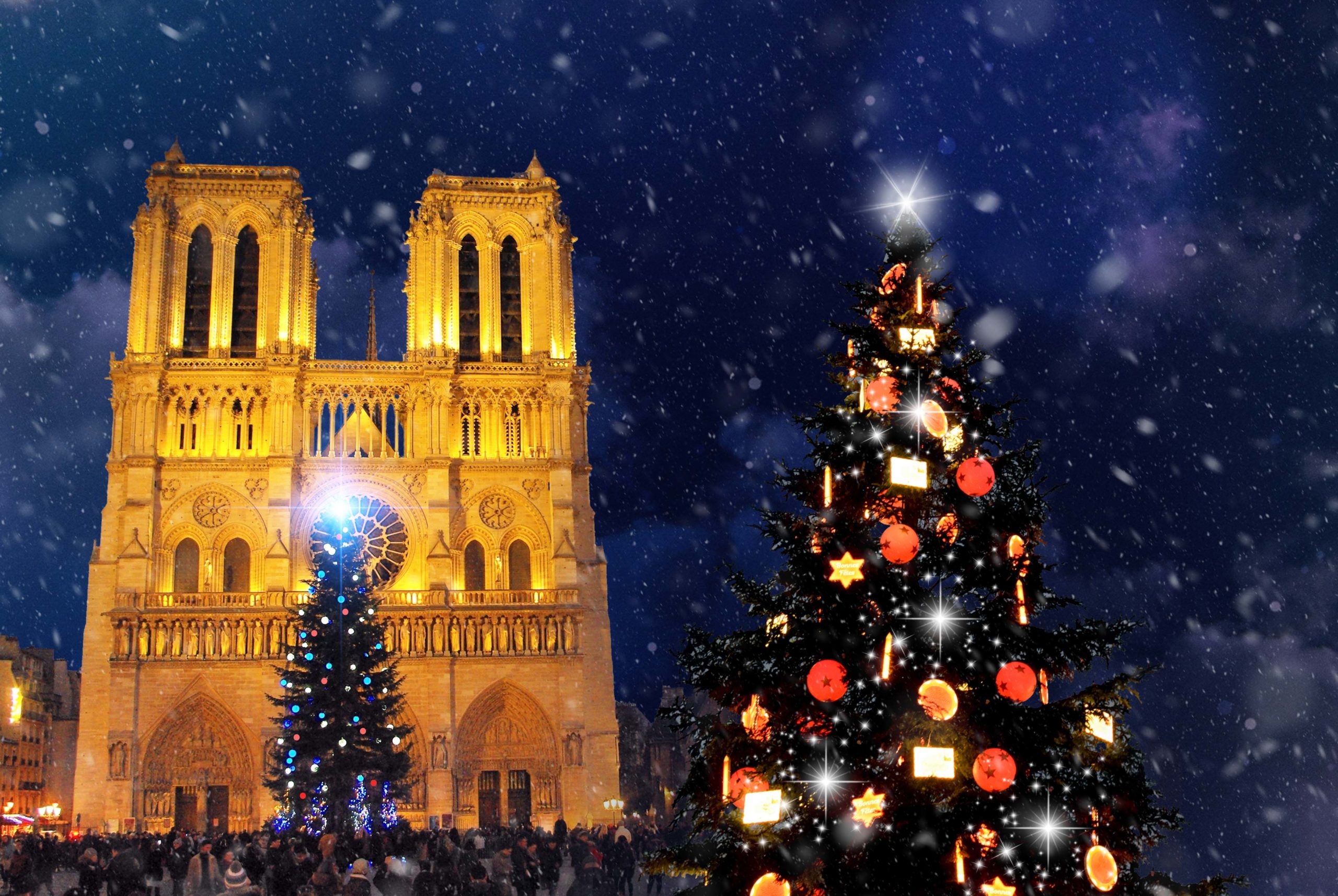

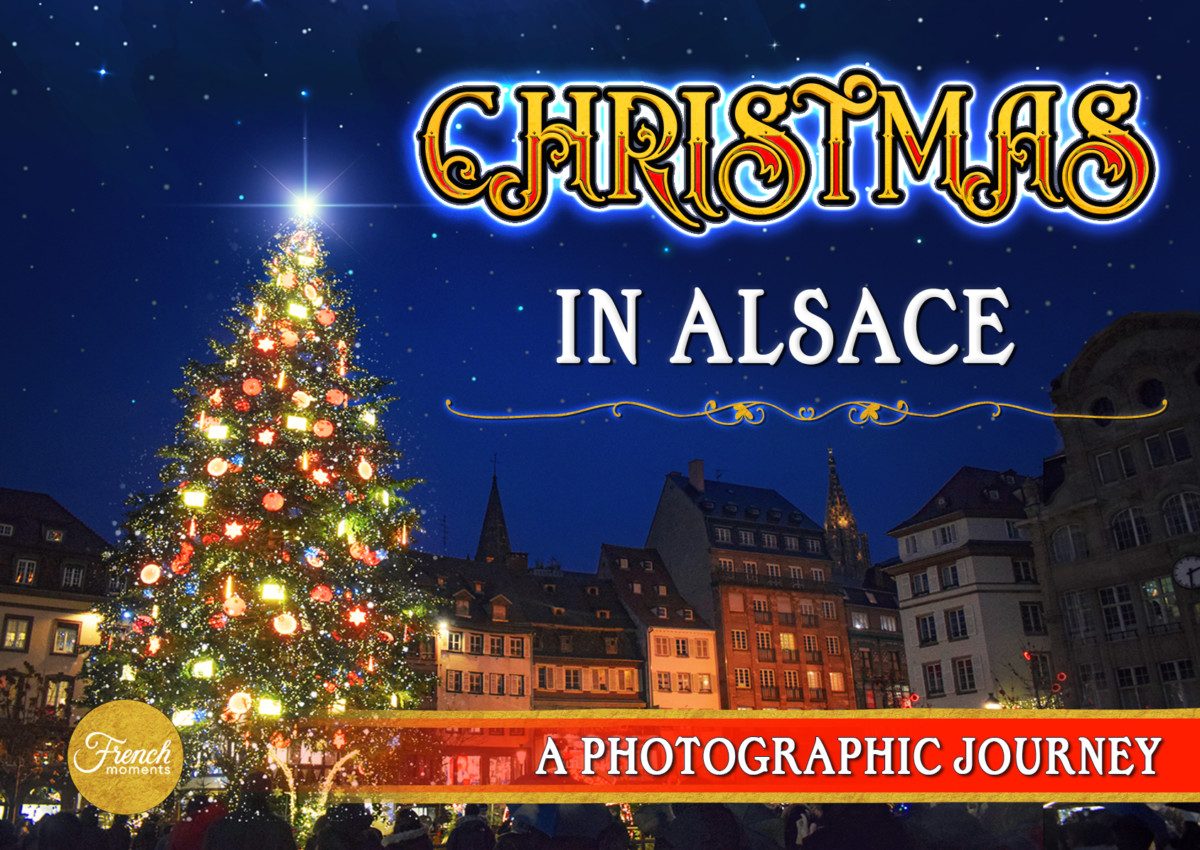
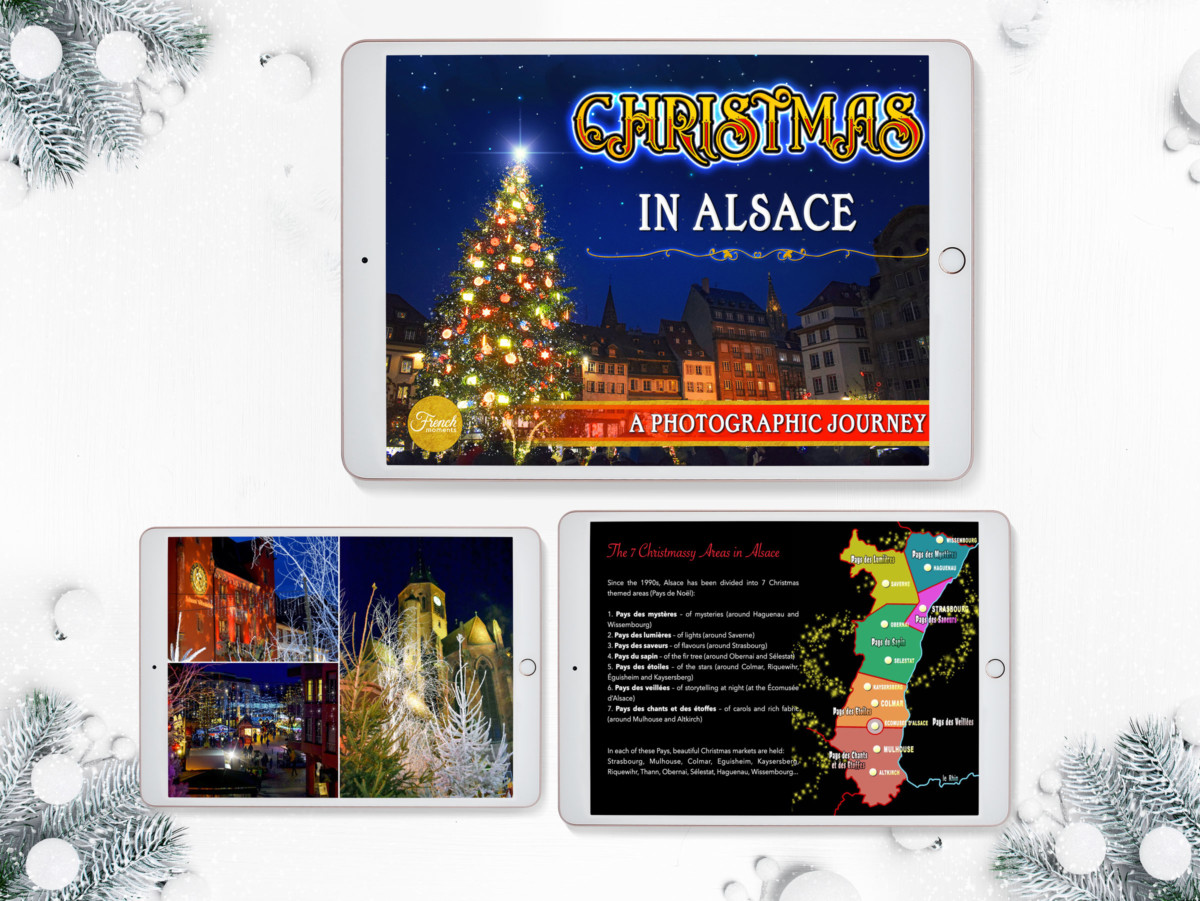


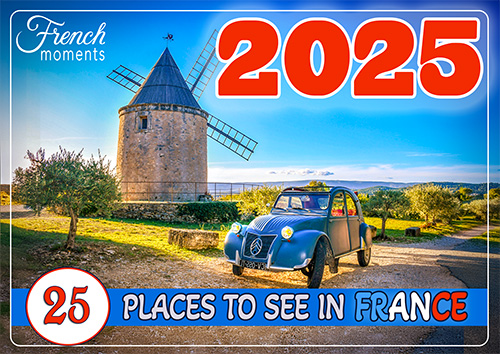
This is very informative information describe in the post. Thank you for the post.
You’re welcome Andrea! 🙂